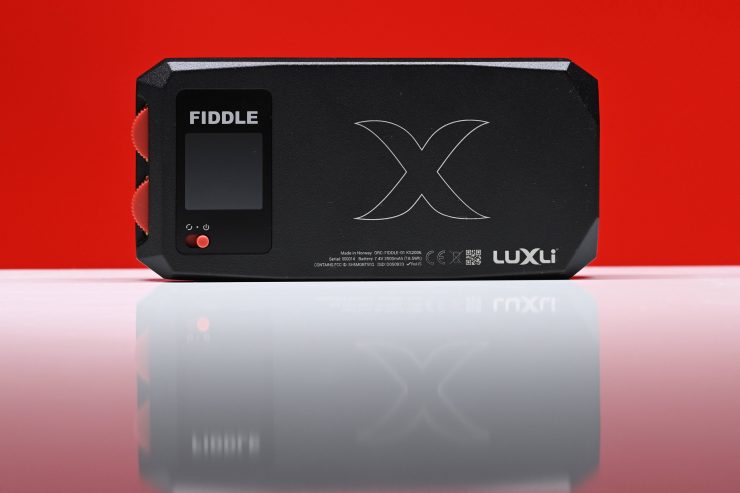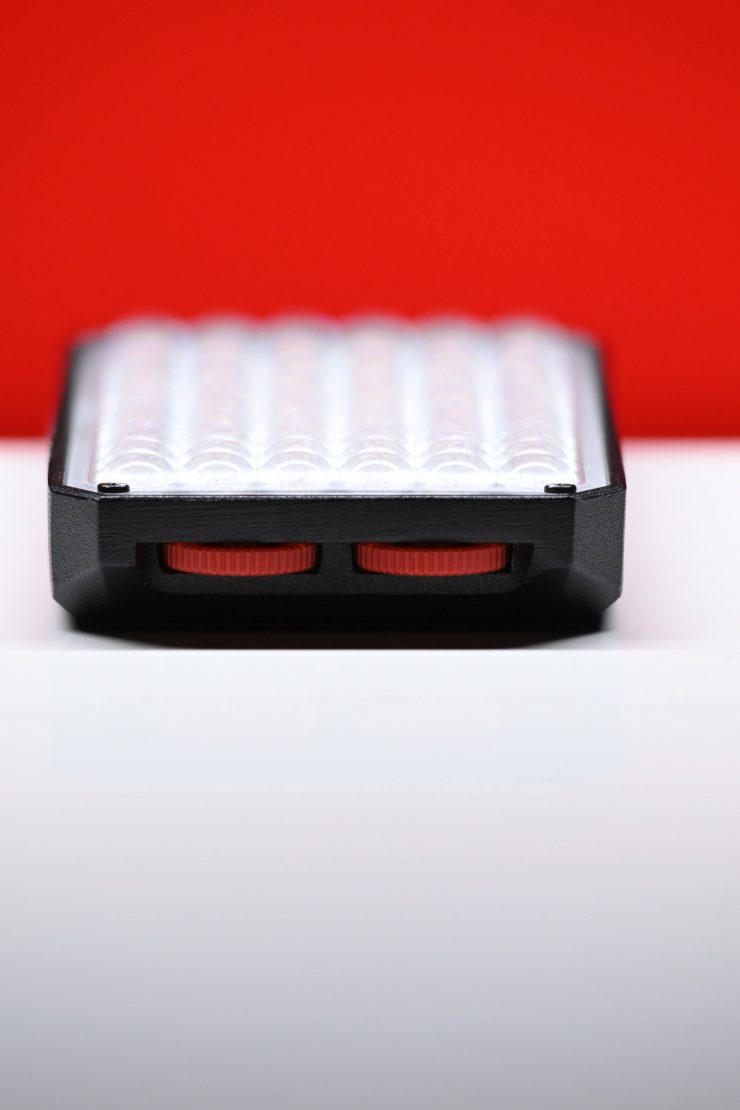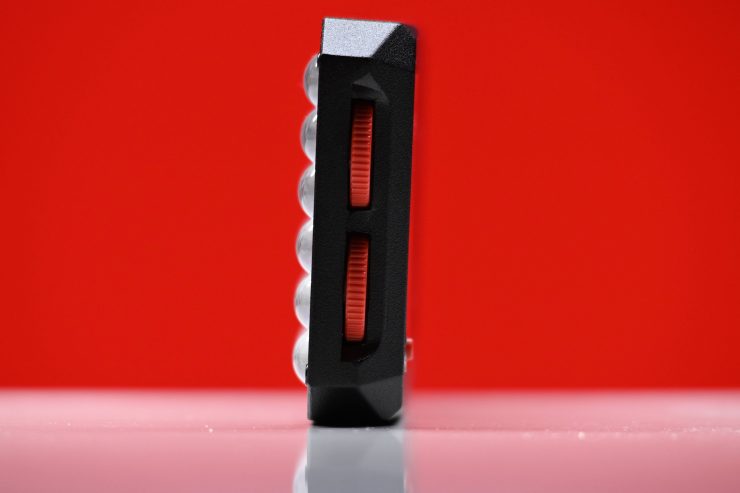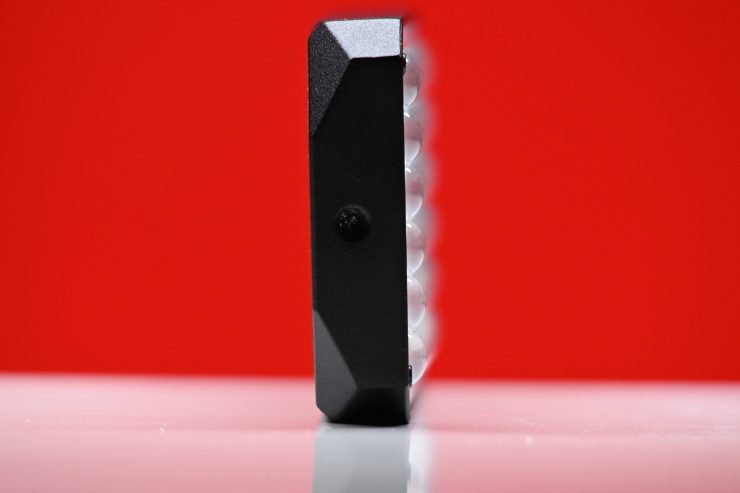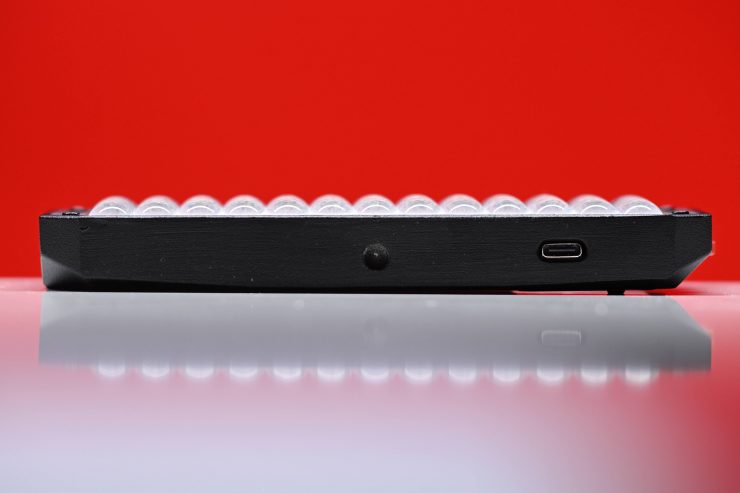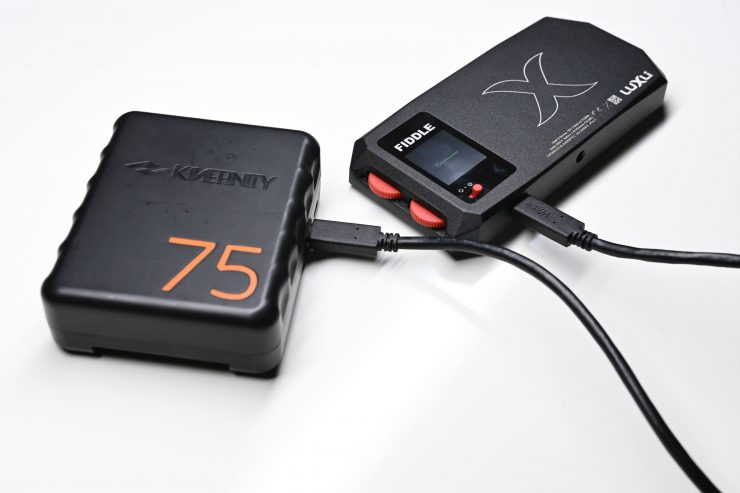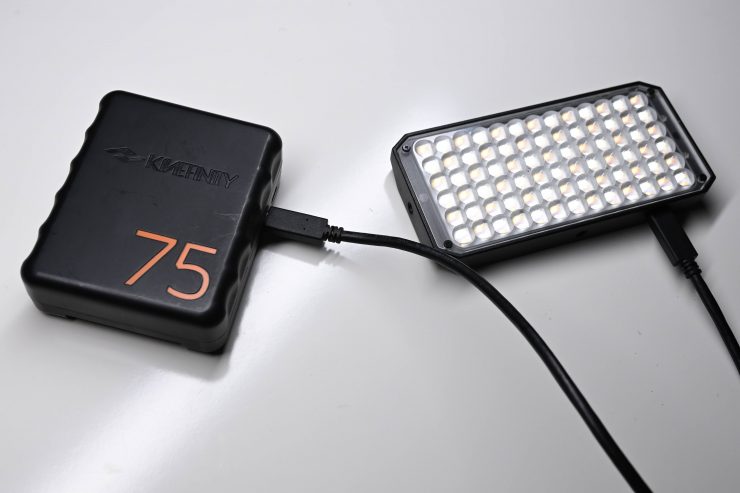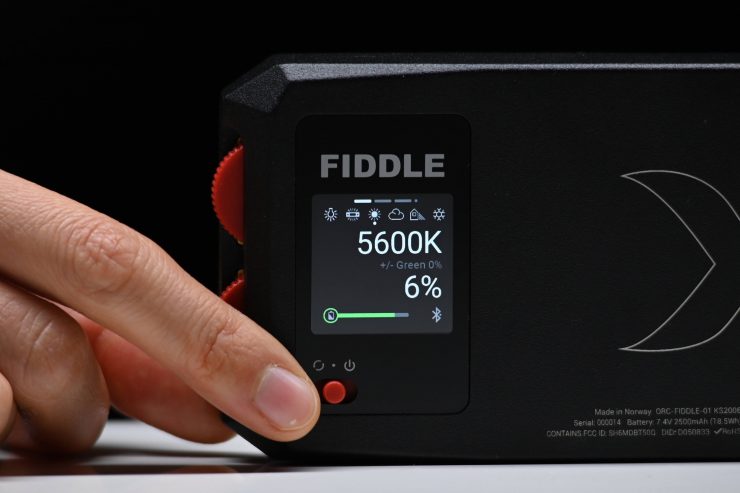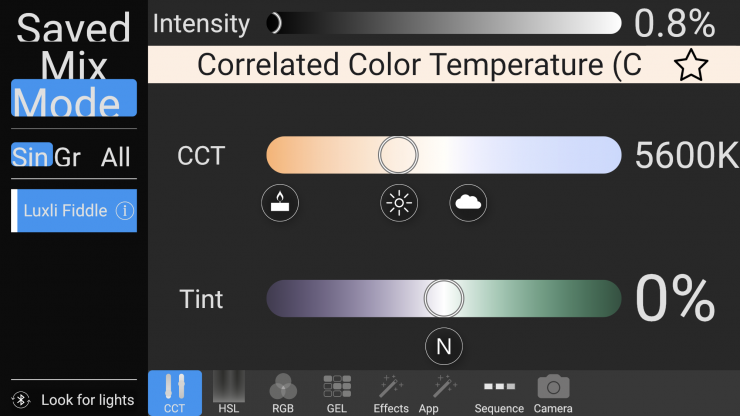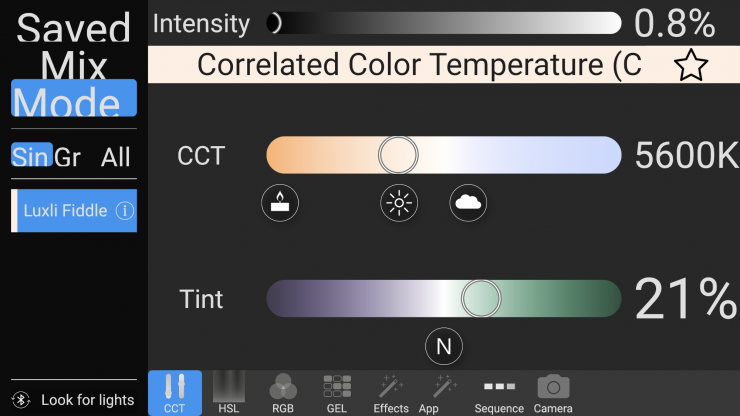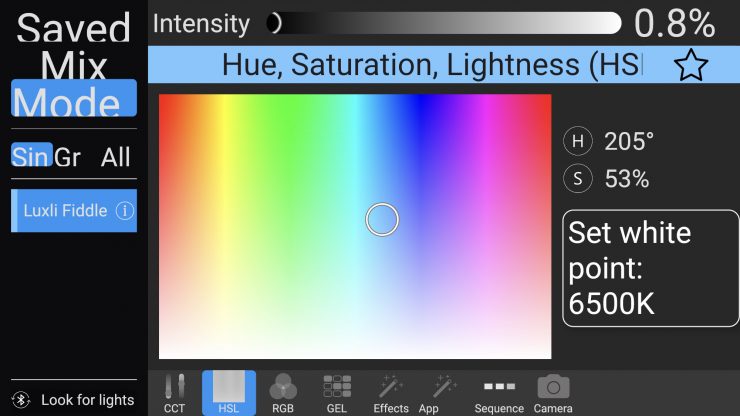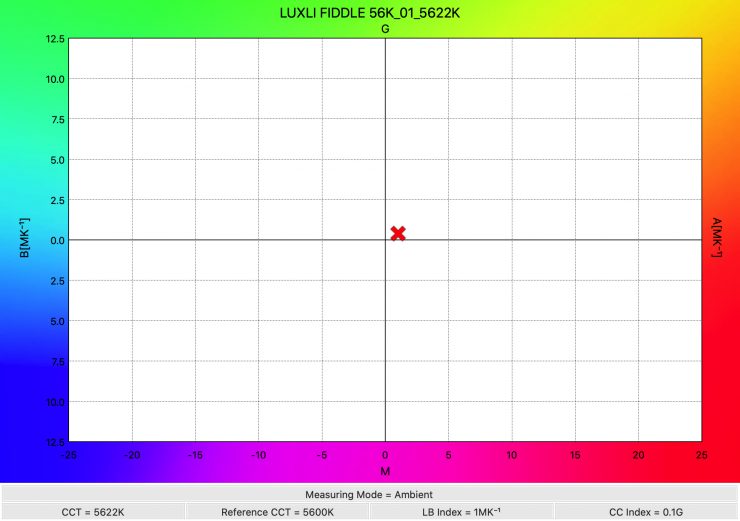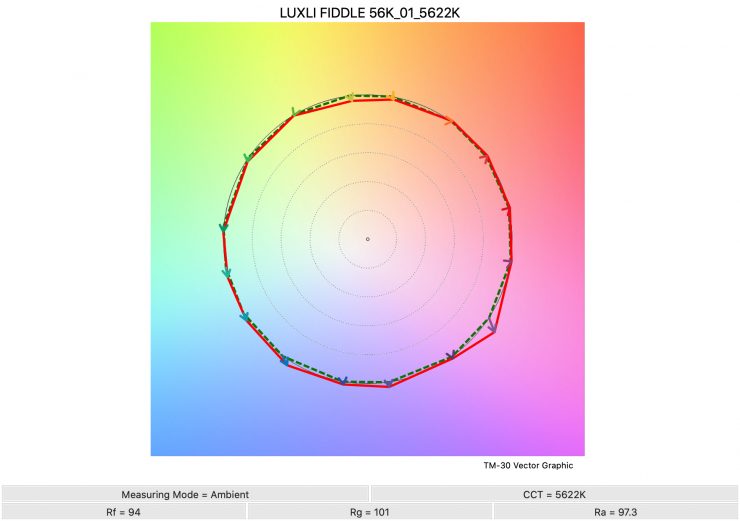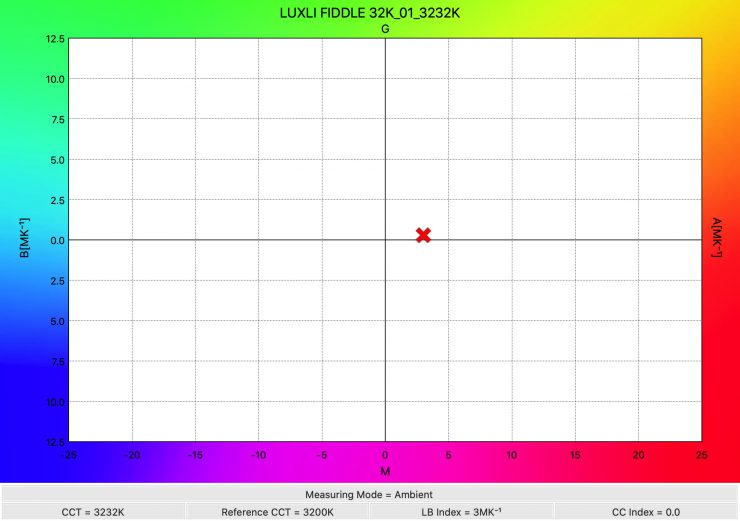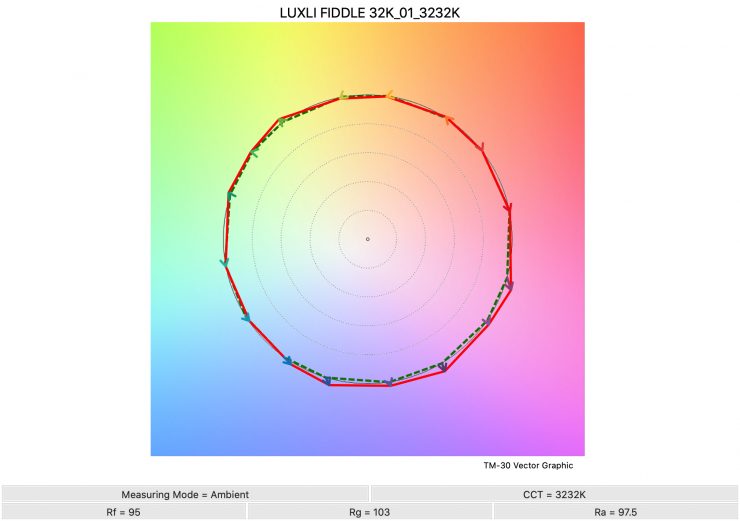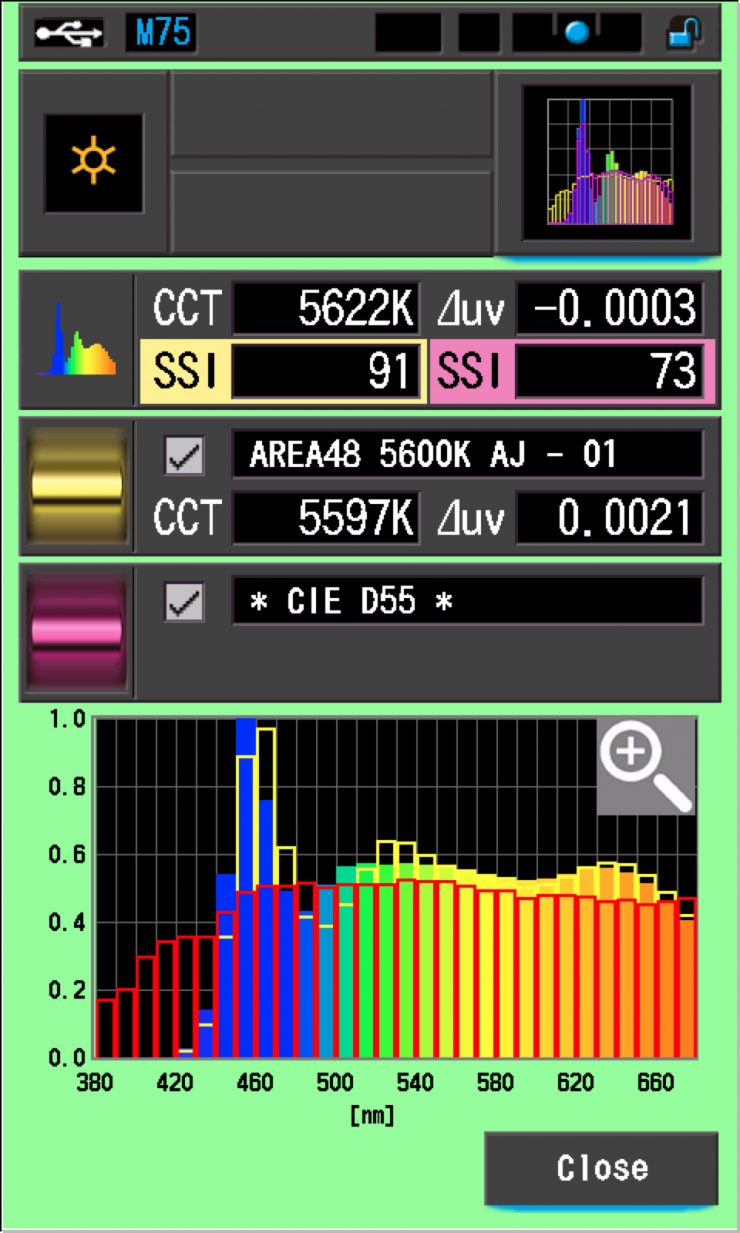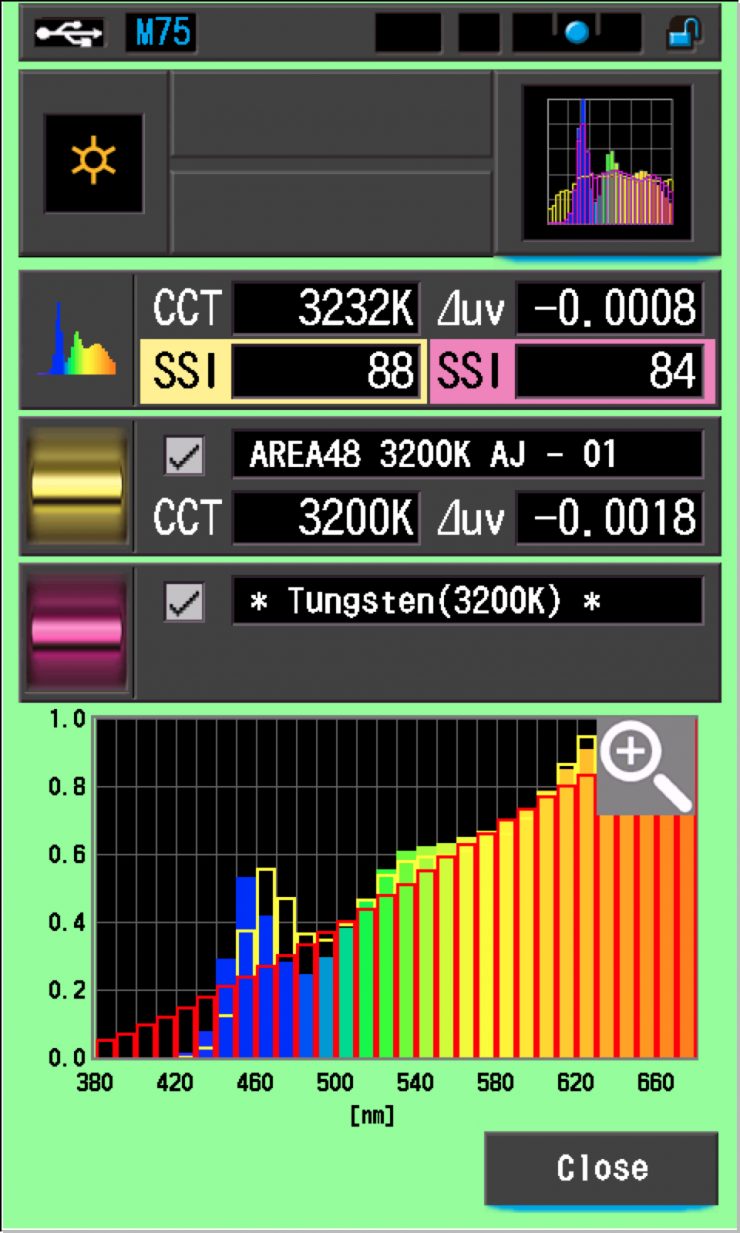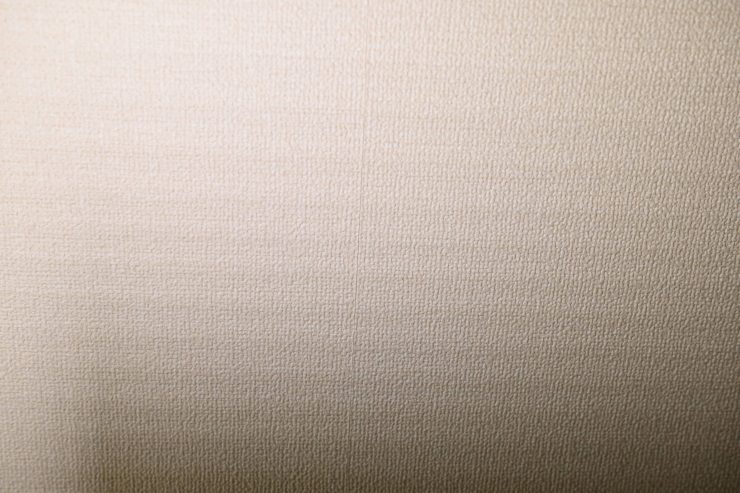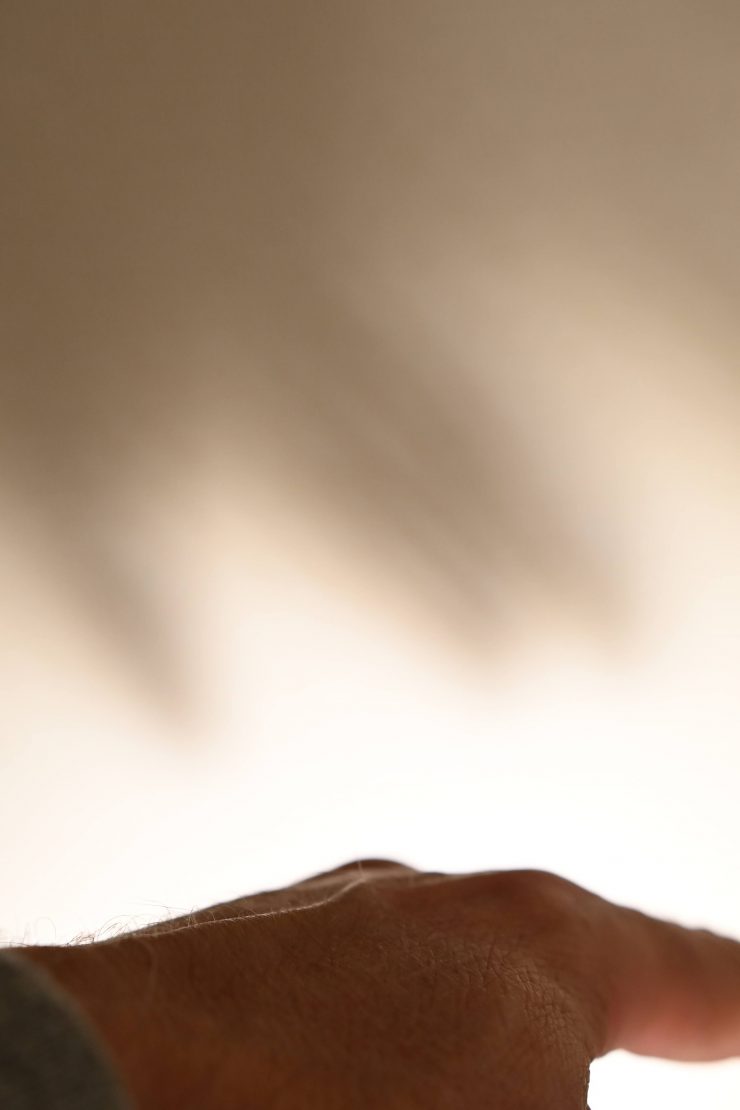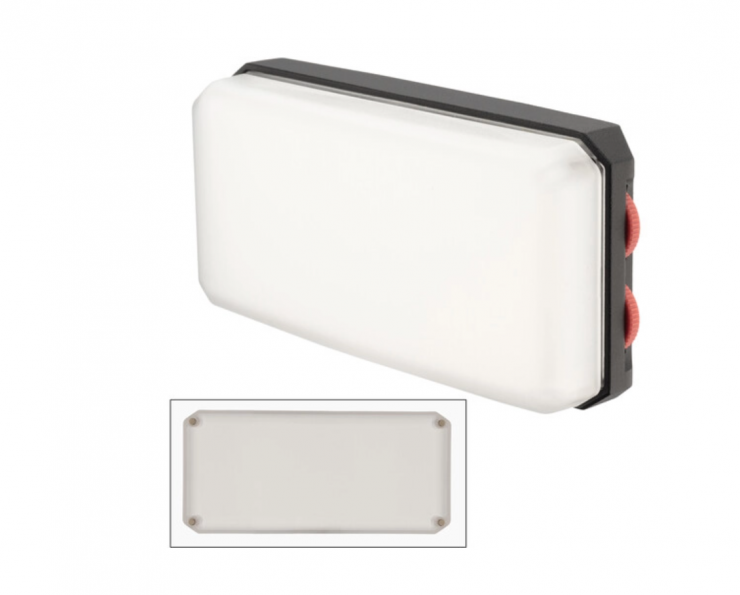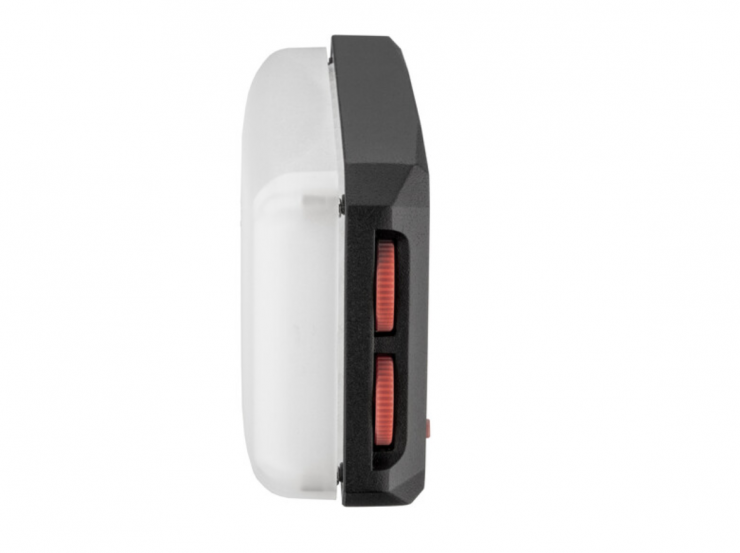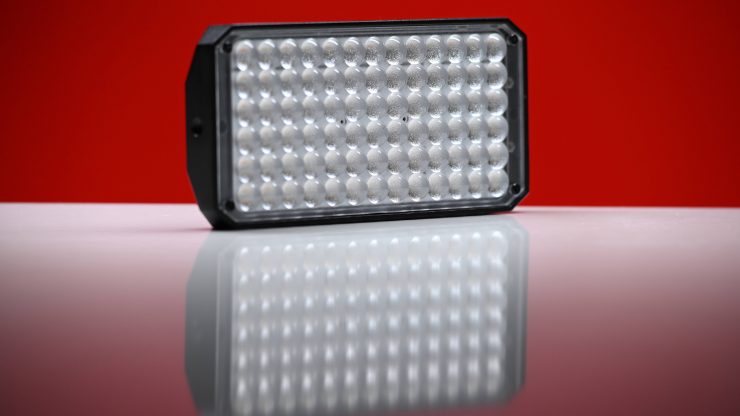
The Luxli Fiddle Pocket is the Norwegian lighting company’s latest RGBAW LED light. It is being touted as a compact, versatile lighting solution, with good color rendition and a host of features.
I have reviewed both the Timpani and the Taiko on the site before and I was very impressed with both fixtures. Hopefully, the Fiddle Pocket lives up to my expectations.
Key features
- 5″ RGBAW LED panel
- Internal battery with 3-hour run time
- 2800 – 10,000K CCT range
- Bluetooth 5 equipped with 100 ft. range
- iOS and Android app control
- Extreme color accuracy
- USB Type-C charging
- Multiple operation modes
- LCD display
RGBAW
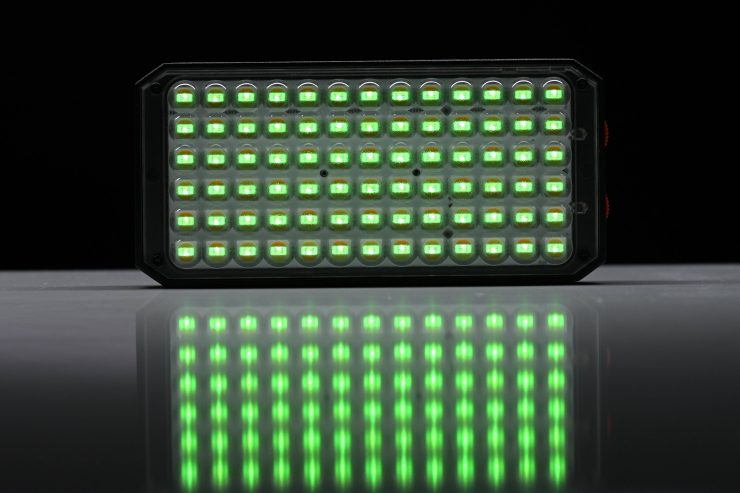
So what exactly is RGBAW? The “A” and “W” in RGBAW stand for amber and white, 2800K and 5600K color temperature LED’s, respectively. Luxli claims that the Fiddle Pocket mixes the output of these two LEDs to ensure an exact color temperature in CCT mode and accurate color reproduction in Gel mode.
Whatever Luxli is doing, they are doing it right. The Timpani and Taiko were some of the most color-accurate lights I have ever tested.
Five-Die LED System
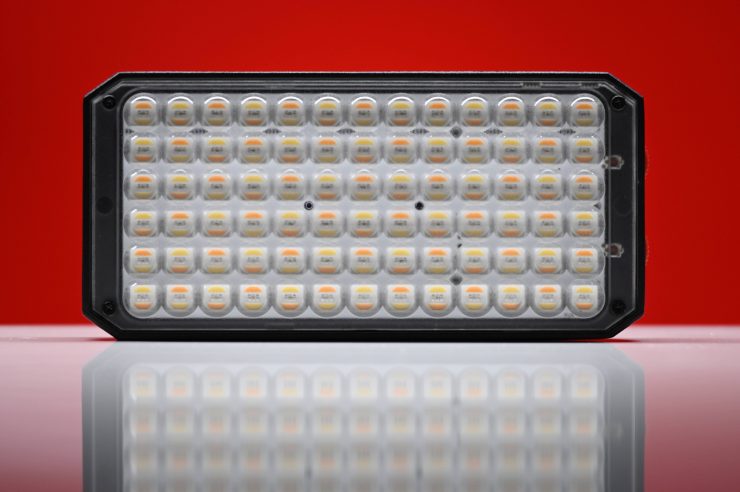
The light utilizes Luxli’s unique five-die RGBAW LEDs that are claimed to deliver exceptional accuracy, and rich saturated colors. To assure that the light exactly conforms to Luxli standards of quality, every Fiddle is individually calibrated and tested before it leaves the factory. A serialized photometric calibration result sheet that lists the lux output, CRI, TLCI, and color gamut is included with every light.
Build Quality
I was very impressed with the build quality of the Timpani and Taiko fixtures, and the Fiddle follows in those footsteps. The Fiddle is beautifully made and the housing is all aluminum.
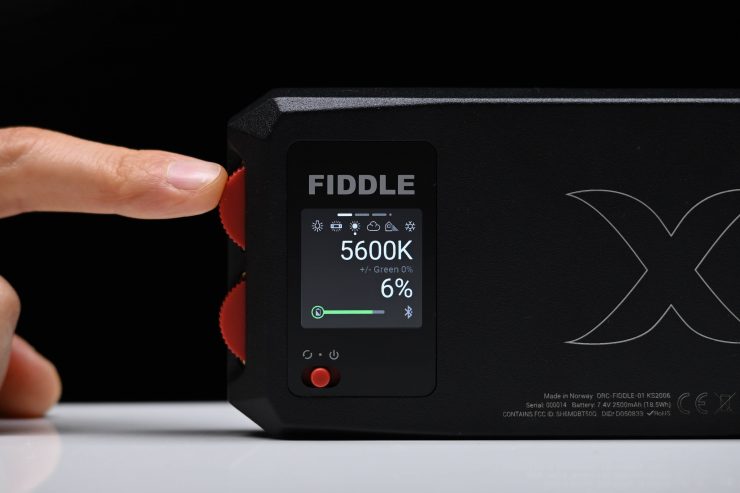
The scroll buttons and switch are nice and tactile, but they are made out of plastic. They do make a clicking noise when you use them and this is something you need to be aware of in case you wanted to change the lights output while recording audio.
Weight & Size
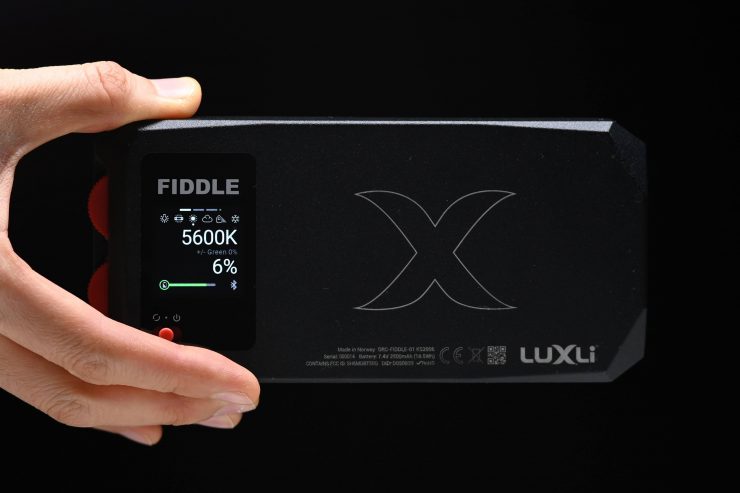
The Luxli Fiddle weighs in at 282g / 9.94 oz, and it has physical dimensions of 6.1 x 2.9 x 0.8″ / 15.4 x 7.3 x 2.1 cm. This makes it relatively lightweight and suitable for use as an on-camera light.
So how does this weight compare to some other similar sized RGBW lights? Below you can see:
| Weight | |
| Luxli Fiddle | 282g / 9.94 oz |
| PFY Matrix Pocket-Sized Portable Bi-Color RGB Light | 249g / 8.78 oz |
| Pilotfly AtomCUBE Rx1 RGBCW Pocket LED | 275g / 9.70 oz |
| YY-C150 RGB LED video light | 265g / 9.34 oz |
| BOLING Pocket LED RGB Video Light | 260g / 9.17 oz |
| Aputure MC RGBWW LED Light | 130g / 4.59 oz |
| Falcon Eyes PockeLite F7 RGBW On-Camera Light | 300g / 10.58 oz |
The Fiddle is a little lighter than some of the other competing lights. However, the weight of the Fiddle is pretty good considering the build quality.
Mounting
The Fiddle has two 1/4 20″ mounting points. One is on the bottom and the other is on the right-hand side of the light.
Power Draw
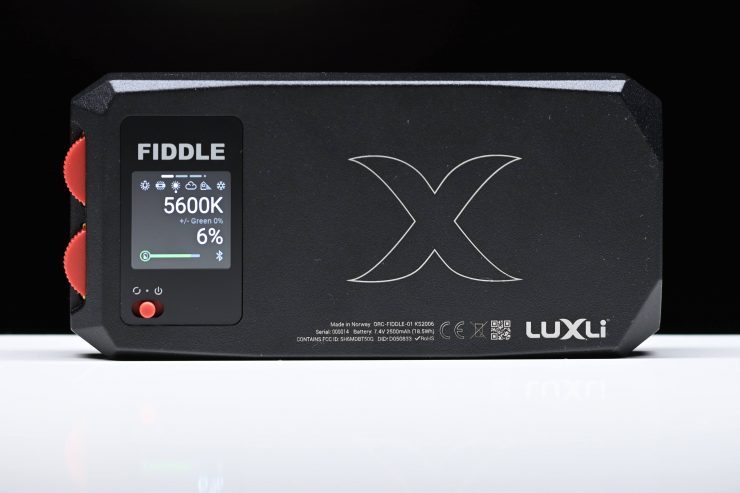
The light draws 18W which is a little higher than most other competing on-camera RGBW lights.
So how does the power draw compare to other similar fixtures:
| Power Draw | |
| Luxli Fiddle Pocket | 18W |
| PFY Matrix Pocket-Sized Portable Bi-Color RGB Light | 14W |
| Pilotfly AtomCUBE Rx1 RGBCW Pocket LED | 15W |
| YY-C150 RGB LED video light | 12W |
| BOLING Pocket LED RGB Video Light | 12W |
| Aputure MC RGBWW LED Light | 5W |
| Falcon Eyes PockeLite F7 RGBW On-Camera Light | 12W |
The Luxli Fiddle, like a lot of small, compact on-camera style LED lights, features an in-built battery.
| RUN TIME | |
| LuxliFiddle Pocket | 180min |
| PFY Matrix Pocket-Sized Portable Bi-Color RGB Light | 240min* |
| Pilotfly AtomCUBE Rx1 RGBCW Pocket LED | 180min |
| YY-C150 RGB LED video light | 180min* |
| BOLING Pocket LED RGB Video Light | 140min* |
| Aputure MC RGBWW LED Light | 120min |
| Falcon Eyes PockeLite F7 RGBW On-Camera Light | 110min* |
*Claimed run times (not tested)
Above you can see how long the internal battery lasts compared to the competition.
Built-in batteries certainly have their pros and cons. Yes, it is nice to grab a light and not have to worry about finding a battery and putting it onto the back of a light, but the flip side is, once that internal battery dies you can’t use the light anymore. If you are going to put an internal battery in a light it needs to be able to power the light at full power for at least 2-3 hours to be useful.
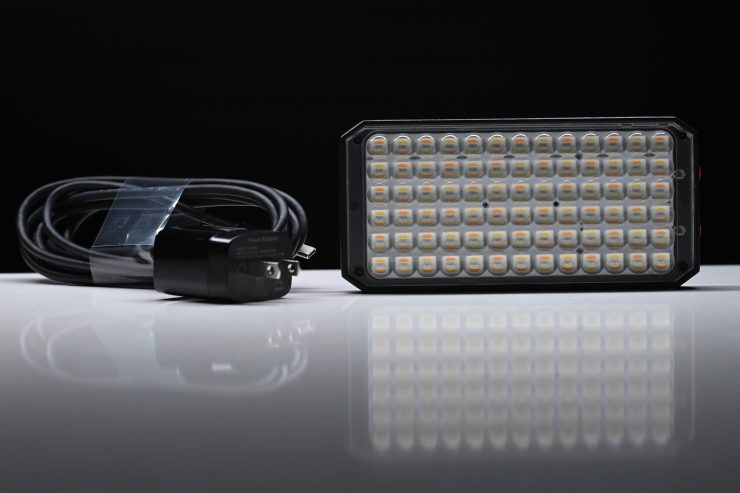
With the Luxli Fiddle, you can power and charge it at the same time through the included USB-C wall charger. This is a nice feature to have because sometimes you do want to run a small light off mains power.
You can also power and charge the Fiddle at the same time if you connect it to a USB-C power device. Above I am running the light off the USB-C output on the Kinefinity V-lock battery. This is very handy if you were using the Fiddle as an on-camera light because you could power it off your camera battery for continuous uninterrupted use.
More than just a light
Gone are the days where a light was just a light. A lot of today’s modern lights are now a seamless blend of hardware and firmware.
Having a light that is firmware updateable helps extend its life and adds extra functionality over time.
Controls & Menu System
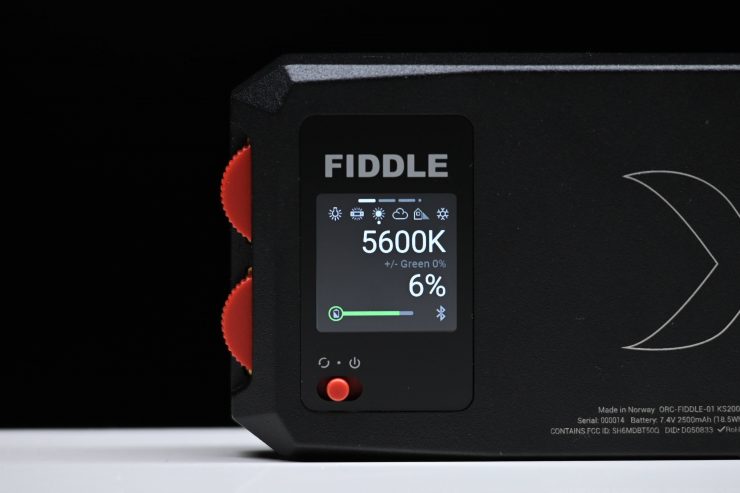
If it ain’t broke, don’t fix it. If there is one thing that Luxli does very well across the board, it is control interfaces. Despite how many features you have in a light, that light should be easy to use and operate. Nobody wants to get lost in endless menus or have to remember weird button combinations to make changes.
The rear LCD screen is easy to see and it gives you clear and concise information about the light.
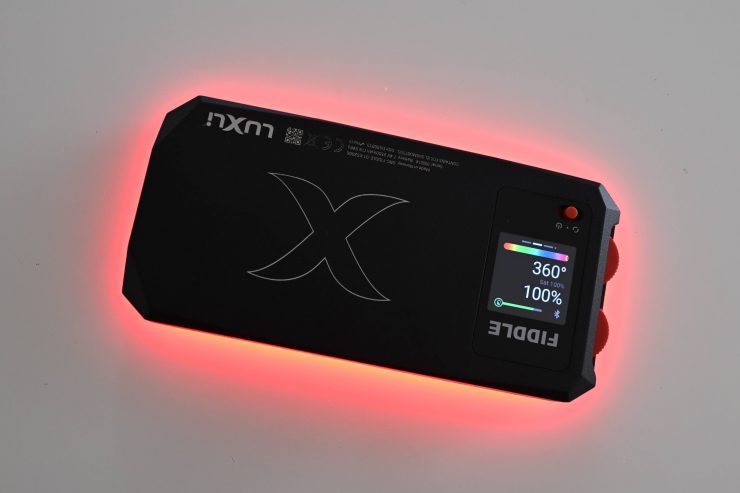
What is nice is that you can flip the light upside down and the display will also flip. This may be a small thing, but it is incredibly useful during real-world operation.
The Fiddle Pocket uses a combination of dials and a button. It is easy to cycle through the various modes and make changes.
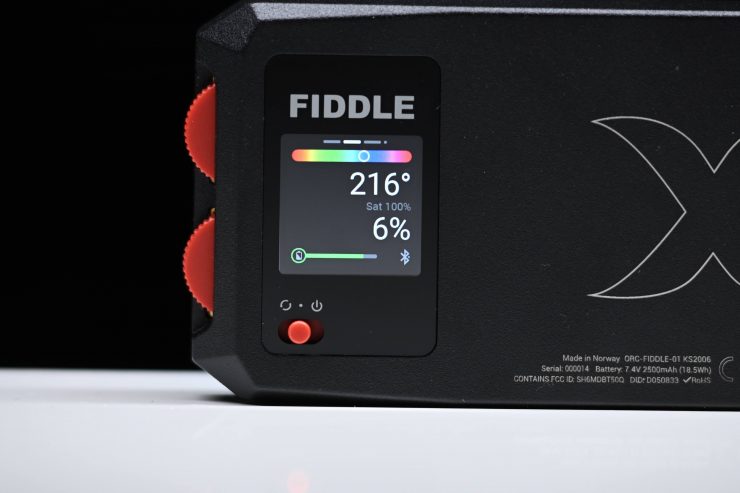
It is pretty easy to make adjustments and changes on the Fiddle. I like how there is a virtual color pallette displayed when you are in the RGB Mode. This makes selecting the color you are looking to create a whole lot easier.
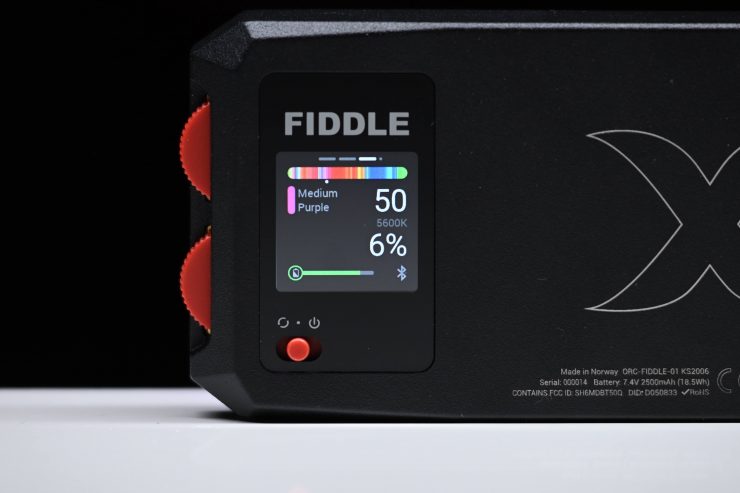
In the Gel Mode, you can also see visual color indicators of the gels you are selecting. This is way better than just having a gel name listed. It allows you to know what type of look that particular gel is going to create.
Operating Modes
CCT Mode
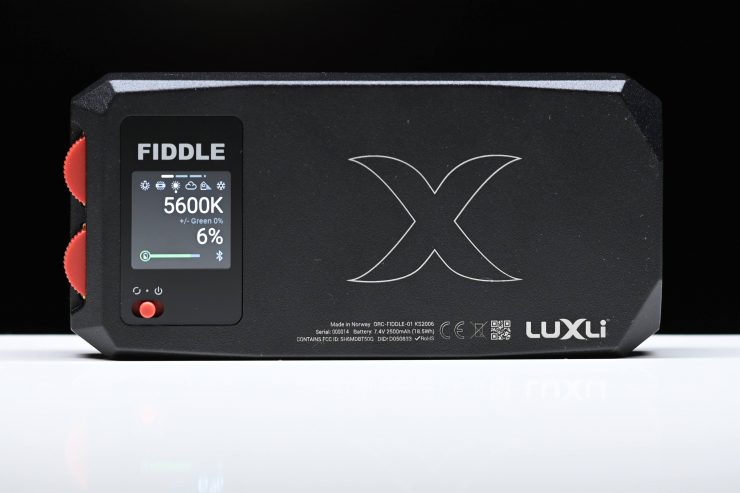
The traditional correlated color temperature (CCT) mode allows you to adjust your color temperature from 2800 to 10,000K in 50K increments. This lets you emulate any lighting condition, from the cool hues of bright sunlight to the warmth of a tungsten bulb. Dimming can be done in increments of 1%. Unlike some lights, the Fiddle actually stays on all the way down to 1%.
CCT Mode is the one most users will find themselves using the most often.
RGB Mode
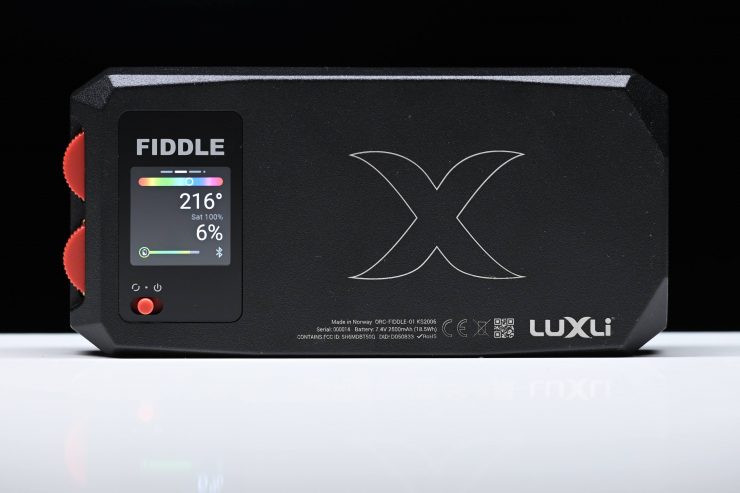
In the RGB Mode, you can scroll through the RGB color wheel in 1° increments. This allows you to dial in nearly any color in the visible spectrum.
Gel Filter Mode
If you select the Gel Filter Mode you can select from up to 150 filters to customize the white light output. Any color temperature available in the CCT mode can be modified by the filter samplings. Included in the filters are useful items such as Chromakey Green and Blue. This filter mode was originally introduced by Luxli in their Cello, but it didn’t have anywhere near the number of filter options that are found in the Timpani, Taiko, and now the Fiddle.
It is very impressive to see so many filters available in the Fiddle. There is literally a filter for just about any need you may encounter.
Special Effect Mode
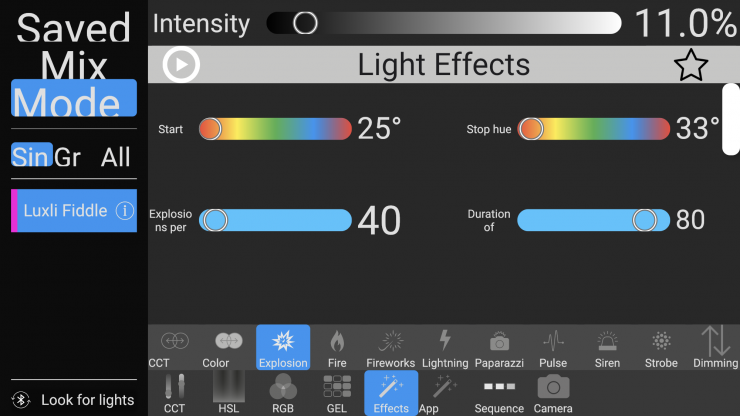
The Fiddle also features a range of special effects, from strobing that imitates lightning strikes and explosions to orchestrated timed color shifts and warning lights. Each effect is adjustable in timing and color temperature. These special effects are nice to have, but realistically they are not something most shooters will use that often. Please note: You can only access the Special Effects Mode through the Luxli Composer App.
If you are interested, you can read what they all do below:
CCT Chase
A continuous loop that changes between two preset color temperatures. Good for simulating a sunrise, sunset, or a change from cloudy to sunny weather in real time. Since the sequence loops, you can shoot multiple takes without reprogramming the light.
CCT Start: Selects the color temperature at the beginning of the sequence (2400 to 10,000 K). CCT Stop: Selects the final color temperature of the sequence (2400 to 10,000 K).
+/- Green: Sets the green/magenta (tint) saturation level in 1% increments from +100% (green) to -100% (magenta).
Time Unit: Select between seconds and minutes for the time loop. Time/Loop: Select how many seconds or minutes the loop will last (1 to 160).
Color Chase
A continuous loop that moves through the color wheel between two selected colors. Since the sequence loops, you can shoot multiple takes without reprogramming the light.
Hue Start: Selects the color at the beginning of the sequence (0° to 360°).
Hue Stop: Selects the final color of the sequence (0° to 360°).
Saturation: Determines the color intensity from 100% (full color) to 0% (white light). Time Unit: Select between seconds and minutes for the time loop.
Time/Loop: Select the duration in seconds or minutes for each loop (1 to 160).
Explosion
Simulates the light from explosions. The Timpani generates random-length pulses and strobes within a range of the red to amber section of the color wheel.
Explosions/Minute: Sets how many separate explosions occur each minute (1 to 360). Duration (%): Set the percentage of time the light is illuminated for each pulse or strobe
(5% to 95%).
Fire
Simulates the light of a candle, campfire, or bonfire in various wind conditions. Fire Type: Select candle, campfire, or bonfire.
Wind Type: Select between no wind, breeze, windy, or storm.
Fireworks
Simulates the light from fireworks. Colors and timing of each flash are random. Explosions/Minute: Sets how many flashes will occur per minute (1 to 50).
Duration (%): Determines the percentage of time the light is illuminated in each cycle. Select from a range of 5% (shortest duration) to 95% (longest duration).
Lightning
Simulates lightning by creating random short and long bursts.
CCT: Selects the color temperature of the lightning flashes (3000 to 10,000 K) in 50 K increments. Interval(s): Sets the interval of seconds between lightning flashes (1 to 60).
Paparazzi
Simulates the random firing of multiple camera flashes.
Intensity: Higher intensity increases the number of random flashes per second (0 to 100).
Bulb Type: Determines the length of each flash. Slow is the longest duration. Modern is the shortest duration. Choose from Slow, Medium, Fast, and Modern.
CCT: Sets the color temperature of the flashes from 2800 to 10,000 K+/- Green: Sets the green/magenta (tint) saturation level in 1% increments from +100% (green)
to -100% (magenta).
Pulse
Offers a steady pulse at a programmable rate. Similar to the Strobe special effect (below), but the light fades on and off.
Hue: Selects the light color (0 to 360).
Saturation: Determines the color intensity from 100% (full color) to 0% (white light). Pulses/Minute: Sets how many times the light will pulse each minute (1 to 200).
Siren
Simulates the flashing lights of an emergency vehicle, like a police car or ambulance.
Colors: Select the color combination of flashing lights. Choose red, blue, and white; red and blue; red and white; blue and white; blue; red; or SAE Amber.
Flash/Cycle: Set the number of times each individual color will flash within the cycle. Choose from 1 to 4 times per cycle.
Cycles/Minute: Determines how many repetitions of the cycle will occur each minute. Choose from 10 to 360.
Duration (%): Determines the percentage of time the light is illuminated in each cycle. Select from a range of 10% (shortest duration) to 90% (longest duration).
Strobe
Offers a steady flashing light at a programmable rate.
Hue: Selects the light color (0 to 360).
Saturation: Determines the color intensity from 100% (full color) to 0% (white light).
Frequency: Changes the number of flashes per second (1 to 25).
Duration (%): Determines the percentage of time the light is illuminated in each cycle. Select from range of 10% (shortest duration) to 90% (longest duration).
Control green & magenta color shifts
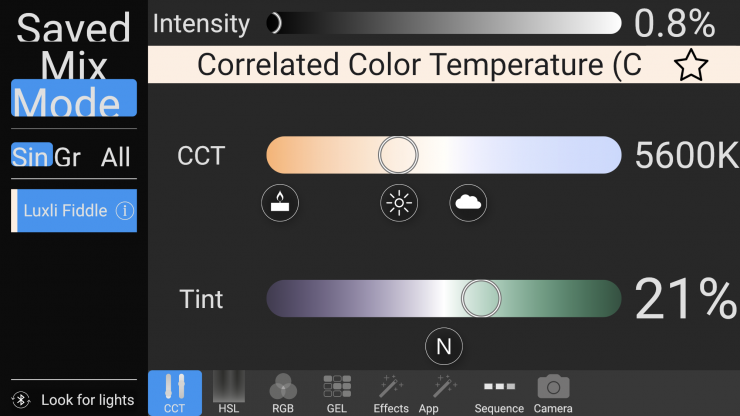
The Fiddle lets you adjust +/-green values from 0-100%. This is an incredibly useful feature that lets you get rid of color casts and makes it easier to match other lights that you may be using. If you are using lights from different manufacturers they are all going to behave differently. By being able to offset green or magenta you can get the Fiddle to closely match another source. For instance, if you happen to be shooting in an office building with overhead fluorescent lights, they may well have a color cast, if you can’t turn them off, you may want to replicate that same look with the Fiddle. By playing with the +/-green values you can.
Unlike some other lights that have +/- green adjustment, on the Fiddle, you aren’t limited to a certain amount of adjustment. The Timpani lets you go from -100% to +100%.
The only negative aspect about the way Luxli has set up the +/-green values is that they have chosen to use values in a percentage form and not in the normal CC values you find in a lot of cameras and some other lights.
The small problem with the Fiddle is that I could only adjust the +/- Green Magenta using the Luxli Composer App.
Pick your color and conduct an orchestra
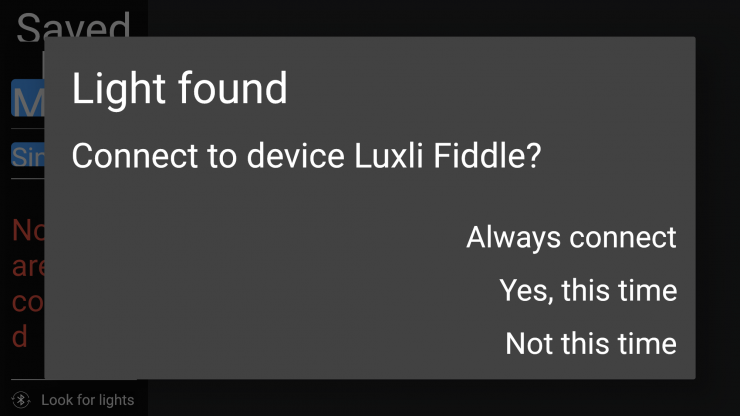
Luxli has a fantastic app that lets you control any of their lights. Any changes made on the app are sent to the Fiddle via Bluetooth at a distance of up to 100′ (30m) away.
The Luxli Conductor app, is available on both iOS & Android devices.
In CCT Mode, you have full control over your Kelvin color adjustment and output, as well as being able to make +/- Green adjustments.
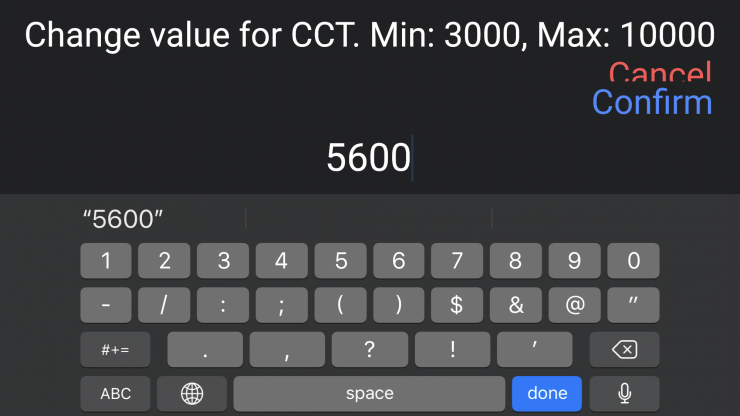
You can also dial in your exact Kelvin color temperature without having to use the slider.
In the RGB Mode, any color on the color wheel can be selected with 1° increments. Saturation can also be controlled to mix the desired color with white light.
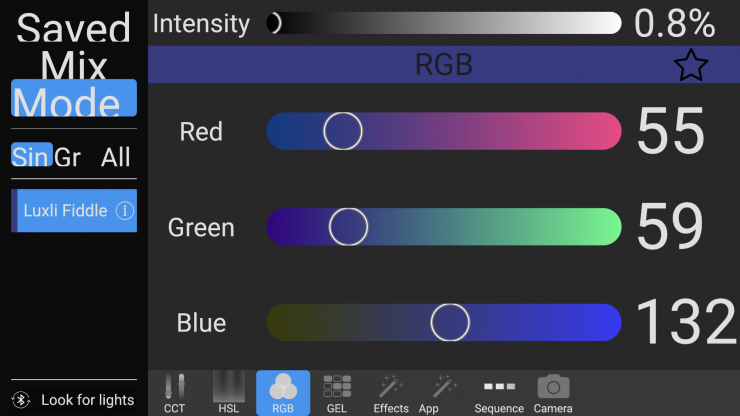
In the HSI Mode, you can individually select the RED, Green, and Blue channels and make adjustments.
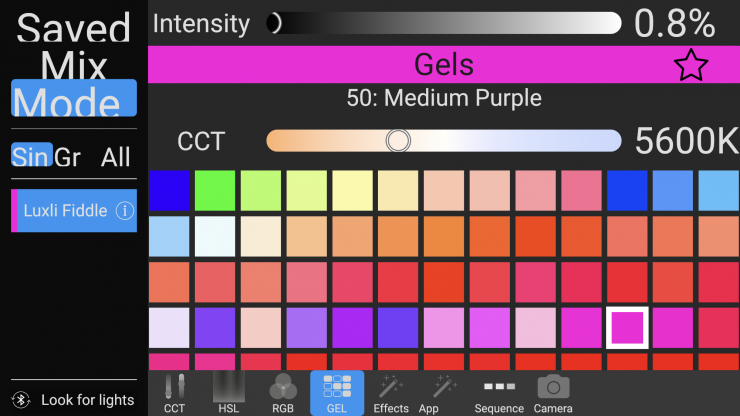
In the Gel Mode, you can select any of the available gels that are found in the light’s extensive catalog.
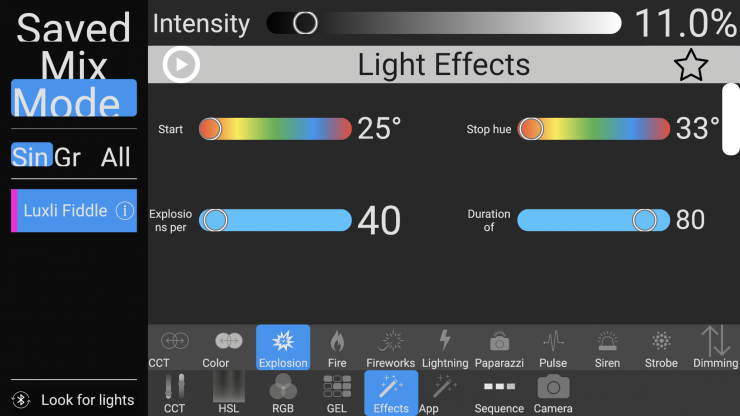
In Effects Mode, you can select and adjust a wide array of special effects.
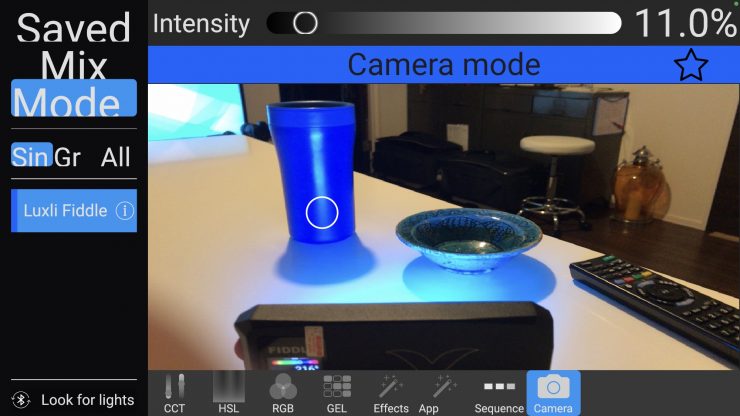
The Camera feature can be used to match any color that you frame up with your camera on a tablet or smartphone. This has been a feature on the Timpani since 2018. This is like a virtual eye dropper. You frame up a color with your camera and then touch the screen and then the light will attempt to replicate that color. It works better with some colors than others.
What I will say is that if you are using multiple Luxli lights you can get them to create identical colors.
The app is nice because it uses Bluetooth and not Wi-fi, so you don’t need to join any networks. All you do is launch the app once the light is turned on and it automatically finds your light and gives you connection options.
You can also combine multiple Luxli lights and synchronize them to operate all at once. You can make changes on one light, which will then be reflected on all of the other connected lights.
For me personally, the ability to be able to control all of these aspects of the light from a smartphone or a tablet is a big deal. It lets me make adjustments to the light while I’m still standing behind the camera so I don’t need to go over to the light, adjust it, and then walk back to the camera to see how it looks.
It also makes controlling RGB modes so much easier as it displays your color palette in a simple, clear interface. Some other RGB lights only show values for red, green, and blue and you have no idea what sort of color you are really creating without making an adjustment and then seeing how it looks. Luxli has taken the sometimes complicated and made it simple.
Beam Angle
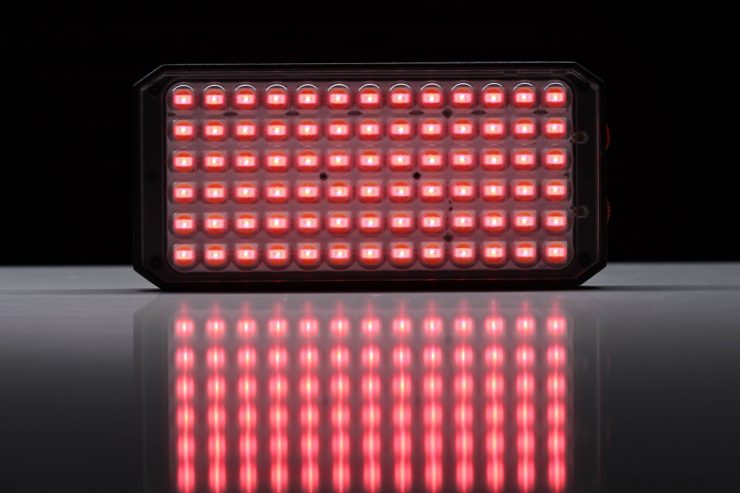
The Luxli Fiddle has a beam angle of 72°. This beam angle provides a reasonably wide spread of light without it spilling out too much.
Photometrics
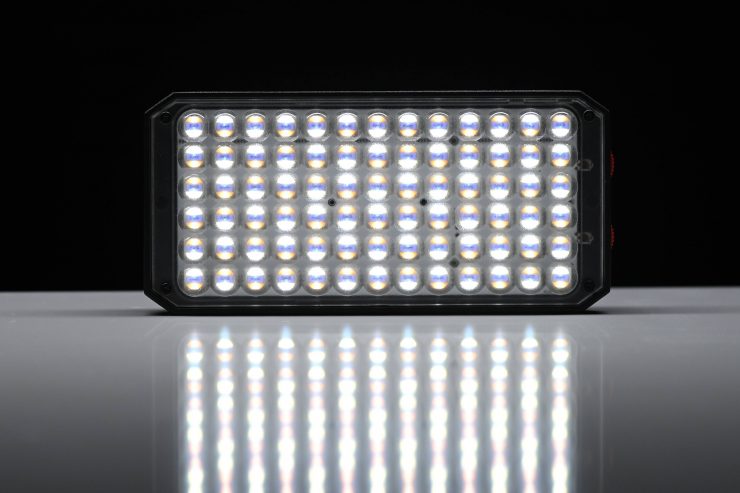
So now let’s get to the photometric results. I always test lights in this way so that I get a reference to how they compare to other fixtures. Results only tell part of the story and should never be used alone to judge a light. I have found from extensive testing over the years that certain lights that have good photometric results don’t always look good, and lights that have worse photometric scores can sometimes look better than their results indicate.
Different lights can also look different depending on what camera you happen to be using.
In a nice touch, every Fiddle Pocket light comes with its own individual photometric results. Not many companies do this and it is nice to see that Luxli does. It shows attention to detail and that lights are not just pushed off some assembly line and thrown in a box.
Output & Color Temperature Accuracy
I tested the Luxli Fiddle at a variety of Kelvin color temperatures with a Sekonic C-800 Spectrometer to find out how much output the light had and how accurate the Kelvin color temperature reproduction was.
Look, it is always nice to have lights that have additional modes and features, but let’s face it, we all want a fixture that can create nice white light.
I tested the light with no diffusion and with diffusion.
All readings are taken at a distance of 1m (3.28ft) in a controlled environment.
5600K
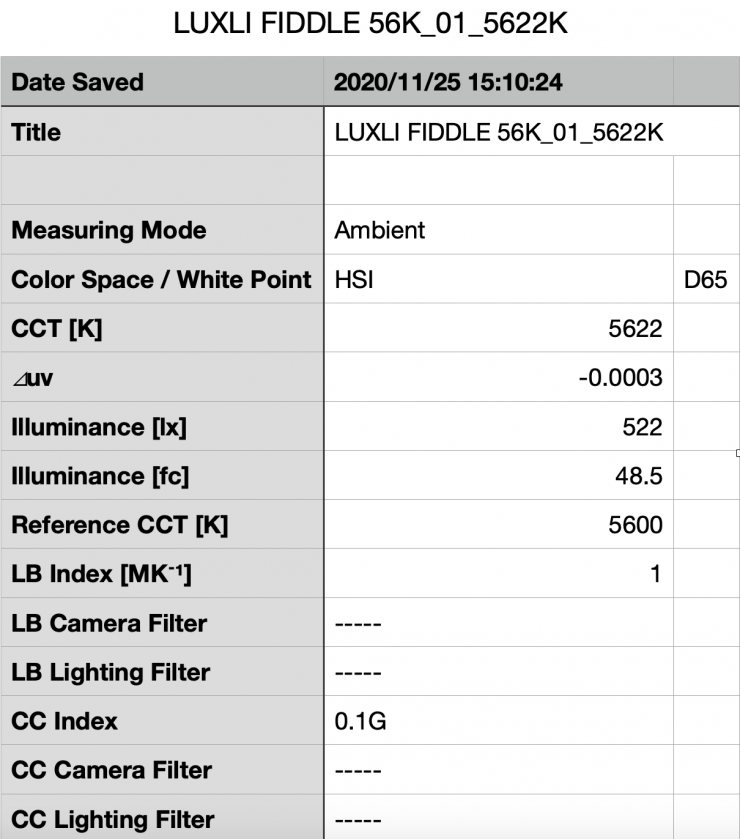
I tested with the medium diffusion panel first, because this is how the light comes as standard. Above you can see the Fiddle recorded an output of 522 lx (48.5 fc) when set at 5600K.
The light recorded a Kelvin color temperature reading of 5622K which was very accurate.
So, how does the output at 5600K compare to the Pilotfly AtomCUBE Rx1 RGBCW Pocket LED Video Light hat I previously reviewed? Well, let’s see.
| Output at 5600K | |
| Luxli Fiddle | 522lx |
| Pilotfly AtomCUBE Rx1 RGBCW Pocket LED | 382lx |
As far as an accurate rendition of creating a 5600K source here is how it compares to the Pilotfly AtomCUBE Rx1 RGBCW Pocket LED:
| Kelvin Color Temperature (when set at 5600K) | |
| Luxli Fiddle | 5622K |
| Pilotfly AtomCUBE Rx1 RGBCW Pocket LED | 5330K |
As you can see, the Luxli Fiddle not only has more output at 5600K, but it is also far more Kelvin color temperature accurate than the Pilotfly.
3200K
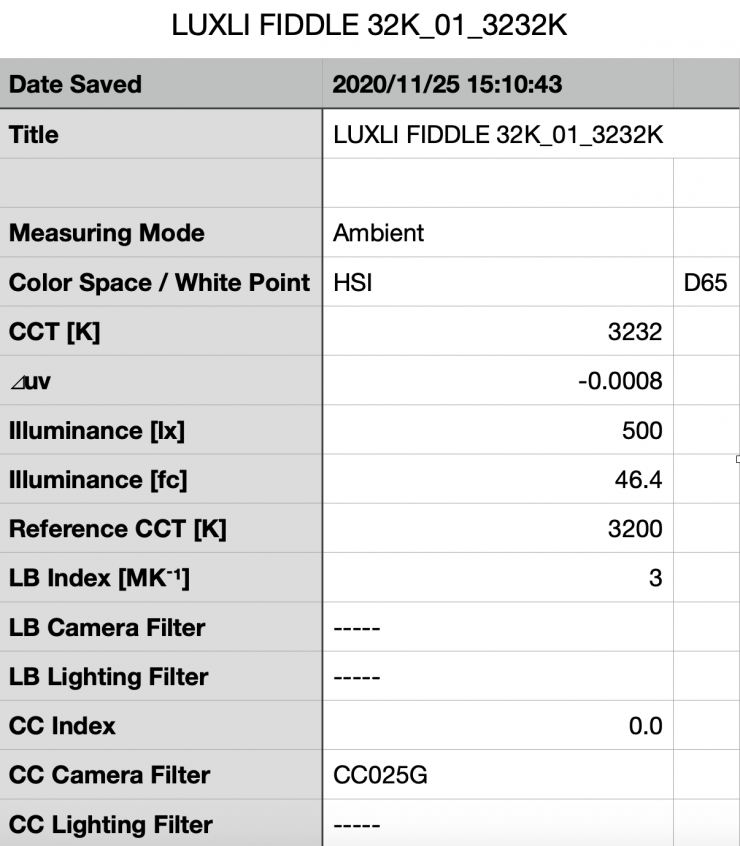
Above you can see the lights output when it was set at 3200K. It produced 500 lx (46.4 fc), which is just 4.2% less than the 522 lx it produced at 5600K.
As far as Kelvin color temperature accuracy goes, it recorded a very accurate reading of 3232K.
So, how does this compare to the Pilotfly AtomCUBE Rx1 RGBCW
Pocket LED? Below you can see:
| Output at 3200K | |
| Luxli Fiddle | 500 lx |
| Pilotfly AtomCUBE Rx1 RGBCW Pocket LED | 371 lx |
As far as an accurate rendition of creating a 3200K source here is how it compares against the Pilotfly AtomCUBE Rx1 RGBCW Pocket LED:
| Kelvin Color Temperature (when set at 3200K) | |
| Luxli Fiddle | 3232K |
| Pilotfly AtomCUBE Rx1 RGBCW Pocket LED | 3317K |
Just like at 5600K, the Luxli had more output and a better Kelvin color temperature than the Pilotfly.
RGB Output
With most RGB lights if you use them to generate or create colors the output gets massively reduced. So how does the Fiddle fare?
I decided to do a test to see how much output the light had when I created a super-saturated color.
In the HSI mode, choosing a saturated red, and set to 100% output, the light recorded an output of 133 lx. This is something you need to be clearly aware of when using RGB and HSI modes. The output is going to be significantly lower than when using the light in CCT mode.
How does it perform at various Kelvin color temperatures?
Summary of results (medium diffusion)
| OUTPUT | KELVIN COLOR TEMPERATURE READING | |
| 2800K | 495 lx | 2808K |
| 3200K | 500 lx | 3232K |
| 4500K | 507 lx | 4548K |
| 5600K | 522 lx | 5622K |
| 6500K | 508 lx | 6529K |
| 8000K | 486 lx | 8027K |
| 10000K | 479 lx | 9912K |
These results show me that the lights output is exceptionally consistent at all Kelvin color temperatures. The lights output only varies by 8.2% across the whole Kelvin spectrum.
This is just the second light (the other was the Luxli Taiko) I have ever encountered where the output is almost dead on at every Kelvin color temperature across the range. This is extremely impressive. Whatever Luxli is doing, they are doing it right.
If there is one word that sums up the Luxli middle, it is consistency. The consistency and accuracy of the Fiddle are second to none.
CC Index & ⊿uv
The CC Index displays the CC correction value and whether any magenta or green need to be added or subtracted. 1 CC corresponds to 035 Kodak CC values or 1/8 Rosco filter values. Any reading less than +1.00 or -1.00 and you’re probably not going to need to make any kind of adjustment. The ⊿uv is the value to show how much this light is away from being an ideal light source (black body radiation = incandescent lamp). As with the CC Index you want this number to theoretically be zero. Kelvin is not a linear value, so we need to convert from Kelvin to MK-1 to compare the values of color temperature. To calculate from Kelvin to Mired is MK-1= 1*1000000/Kelvin. While this may sound confusing, it is the only way of measuring if the Kelvin shift is significant enough to warrant having to use a filter for correction. Below are the results for the Fiddle:
Kelvin Vs MK-1
| Kelvin | Difference in K | MK-1 | Difference in MK-1 | |
| SET VALUE | 2800K | 0 | 357.14 | 0 |
| ACTUAL READING | 2808K | 8 | 356.12 | -1.12 MK-1 |
| SET VALUE | 3200K | 0 | 312.50 | 0 |
| ACTUAL READING | 3232K | 32 | 309.40 | -3.10 MK-1 |
| SET VALUE | 4500K | 0 | 222.22 | 0 |
| ACTUAL READING | 4548K | 48 | 219.87 | -2.35MK-1 |
| SET VALUE | 5600K | 0 | 178.57 | 0 |
| ACTUAL READING | 5622K | 22 | 177.87 | -0.7 MK-1 |
| SET VALUE | 6500K | 0 | 153.85 | 0 |
| ACTUAL READING | 6529K | 29 | 153.16 | -0.69 MK-1 |
| SET VALUE | 8000K | 0 | 125 | 0 |
| ACTUAL READING | 8027K | 27 | 124.57 | -0.43 MK-1 |
| SET VALUE | 10000K | 0 | 100 | 0 |
| ACTUAL READING | 9809K | 191 | 100.79 | 0.79 MK-1 |
These figures might look confusing, but what it tells me is that the light is extremely Kelvin color accurate and you wouldn’t need to use any color correction gels at any of its settings. The MK-1 difference scores are exceptional.
CC INDEX & ⊿uv
| CC INDEX | ⊿uv | |
| 2800K | 0.1G | -0.0010 |
| 3200K | 0 | -0.0008 |
| 4500K | 0 | -0.0006 |
| 5600K | 0.1G | -0.0003 |
| 6500K | 0.3G | -0.0005 |
| 8000K | 0.6G | -0.0002 |
| 10000K | 0.9G | 0.0000 |
Color Rendering
5600K
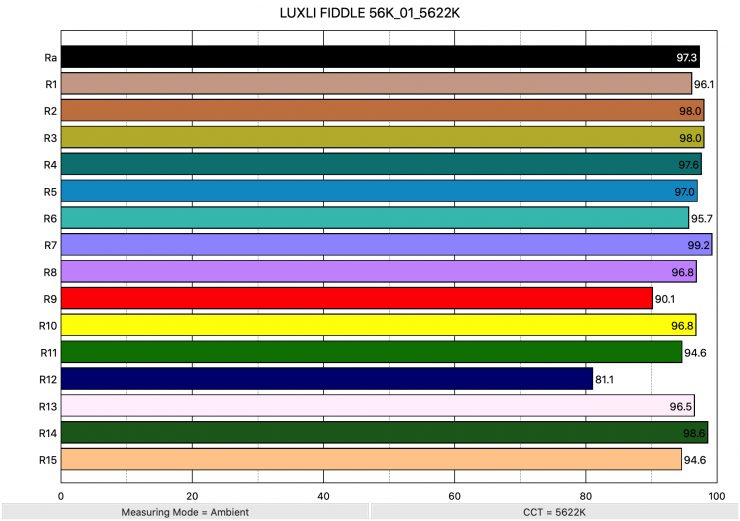
So now that we have seen how much output the Fiddle produces, how does it perform when it comes to replicating accurate colors. Above you can see that when the light was set at 5600K it recorded an average CRI (R1-R8) of 97.6 and an extended CRI (R1-R15) of 95.8. For replicating accurate skin tones it recorded for R9 91.6 (red), 96.8 for R13 (closest to caucasian skin tones), and 95.2 for R15 (closest to Asian skin tones). These are very good results.
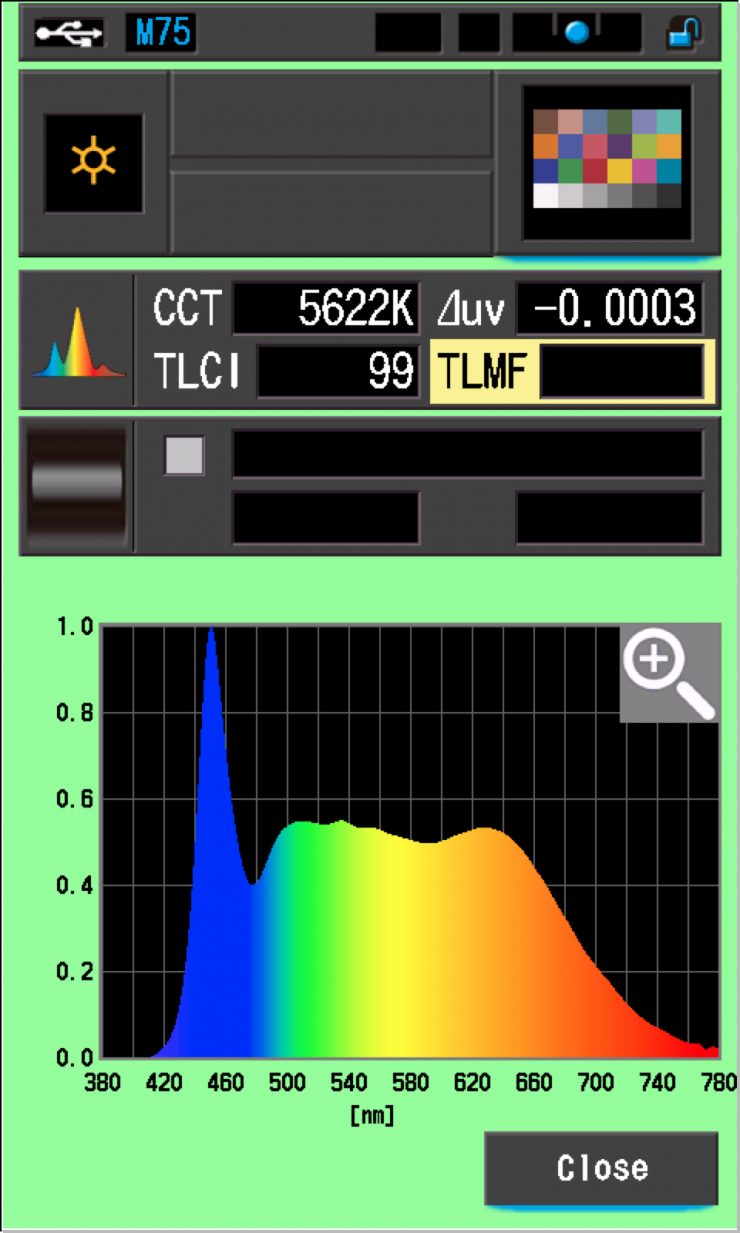
The light, when set at 5600K, recorded a TLCI score of 99. That is almost perfect.
How does this compare to the Pilotfly AtomCUBE Rx1 RGBCW
Pocket LED that previously reviewed when used at 5600K? Below you can see:
| Average CRI | Extended CRI | |
| Luxli Fiddle | 97.3 | 95.38 |
| Pilotfly AtomCUBE Rx1 RGBCW Pocket LED | 94.5 | 92.3 |
3200K
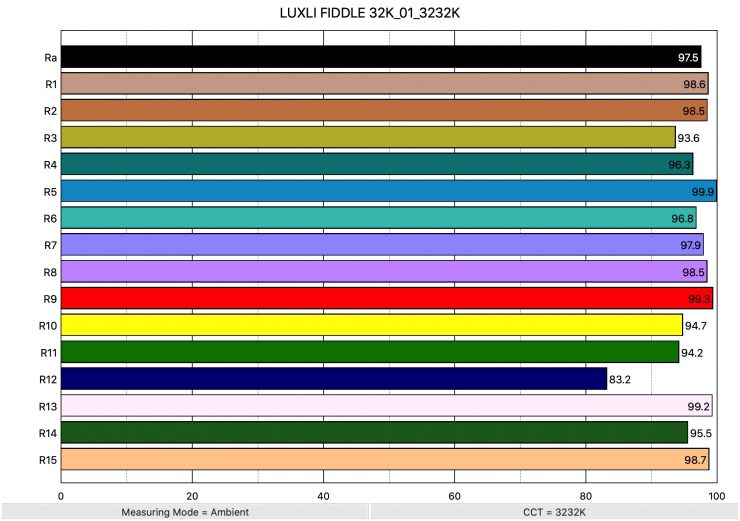
Above you can see the scores for when the light was used at 3200K. It recorded an average CRI (R1-R8) of 97.5 and an extended CRI (R1-R15) of 96.32. For replicating accurate skin tones it recorded 99.3 for R9 (red), 99.2 for R13 (closest to caucasian skin tones), and 98.7 for R15 (closest to Asian skin tones).
These results were some of the best from any light I have ever tested.
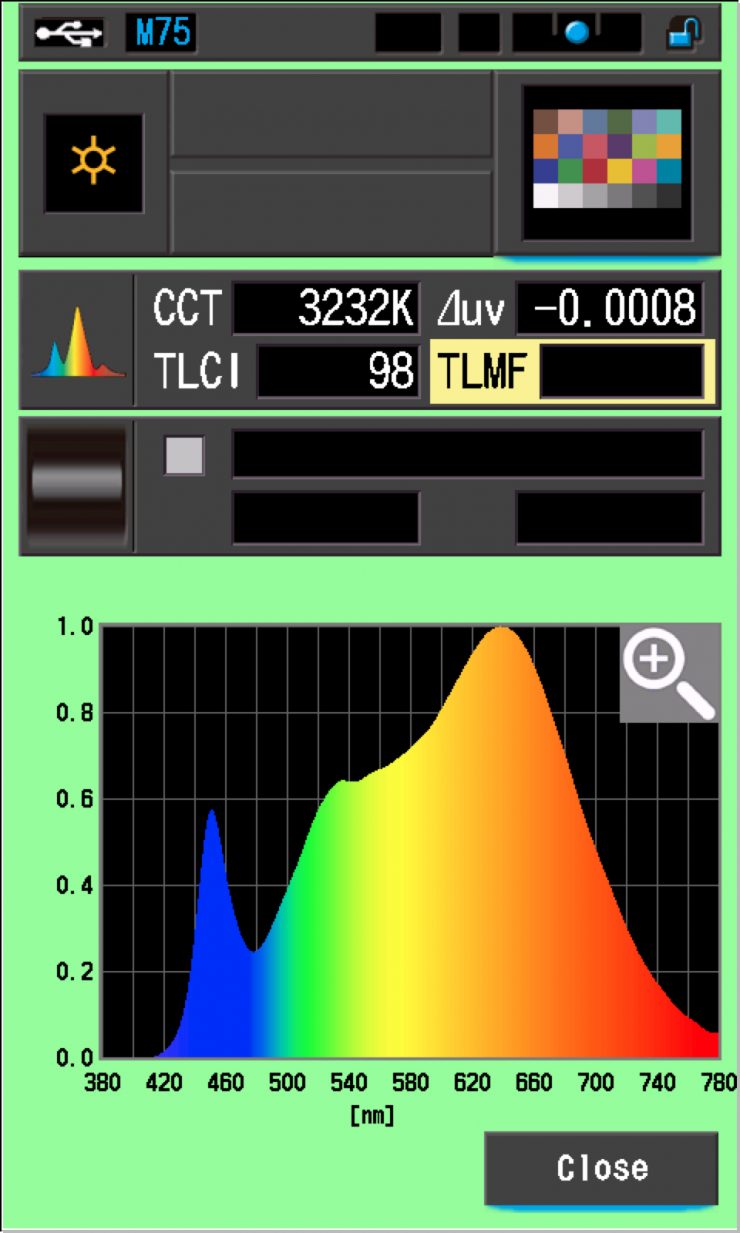
The light, when set at 3200K, recorded a TLCI score of 98.
How does this compare to Pilotfly AtomCUBE Rx1 RGBCW Pocket LED when used at 3200K? Below you can see:
| Average CRI | Extended CRI | |
| Luxli Fiddle | 97.5 | 96.32 |
| Pilotfly AtomCUBE Rx1 RGBCW Pocket LED | 94.7 | 93.2 |
Once again the Luxli Fiddle recorded higher scores than the Pilotfly. In fact, this is the second highest extended CRI score at 3200K that I have ever gotten from any light I have ever tested. The highest was the Luxli Taiko.
Thoughts
The Luxli Fiddle is a highly accurate fixture that replicated colors better than almost any other light I have tested. In fact, the only other light that beat it by a tiny, tiny margin, was the Luxli Taiko. Its scores are exceptionally good across the whole Kelvin color temperature range.
SSI
SSI (Spectral Similarity Index) was developed by the Sci-Tech Council of the Academy. SSI gives me the ability to set any light as a standard, or use predefined standards (such as CIE D55), and then give other lights an SSI score based upon how well they will match standards such as CIE D55. This way I can measure spectral response and compare it directly against an ideal light source. This is actually a much better test than recording CRI scores.
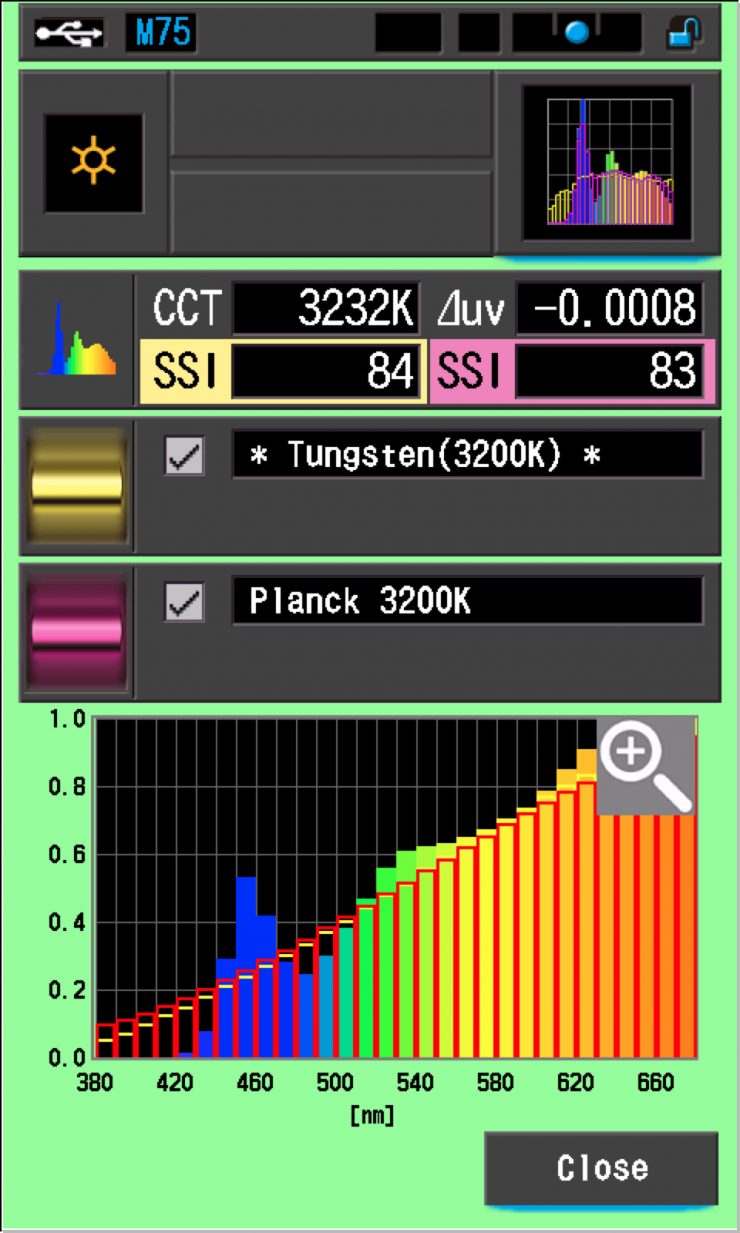
In this graph, the red bars indicate a perfect Planck 3200K source. The gold bars indicate a perfect 3200K Tungsten source. This lets us compare how close to a perfect 3200K lighting source the Fiddle is. Any SSI score in the low ’80s is very good for a 3200K LED light. As you can see, LED lights have a hard time replicating colors below about 450nm.
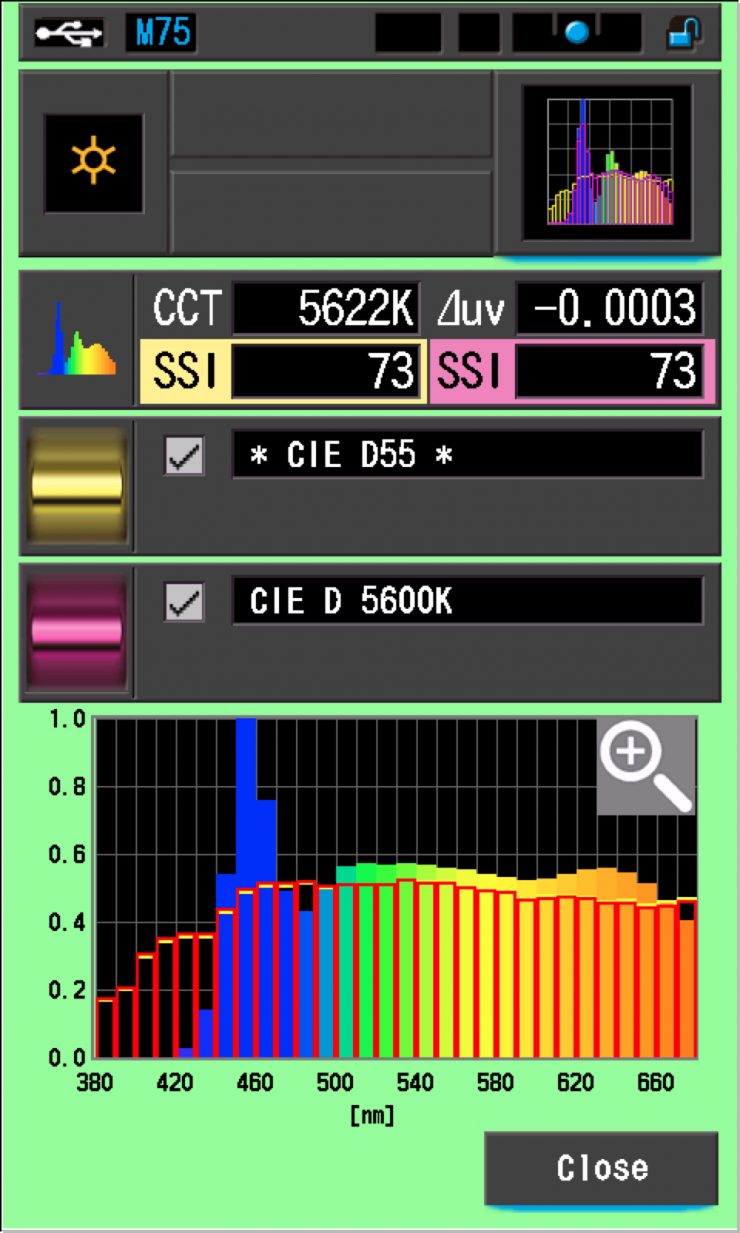
In the graph above the gold bars indicate a perfect CIE D55 source. The red bars indicate a perfect CIE D 5600K source. A score in the low 70’s is very good for a 5600K LED source. If you look at the⊿uv value is -0.0003. The ⊿uv value shows how much this light is away from being an ideal light source (black body radiation = incandescent lamp). This light was almost perfect.
The main reason we want to record SSI scores is so we can see how well they match with other lights. As an example, let’s see how well it matches with a BB&S Area 48 Color. Above you can see the results at 3200K and 5600K. As you can see, the lights didn’t match. Although a low 90’s or high 80’s score, means they wouldn’t be drastically off.
I also tested out the Fiddle and compared it to both the Taiko and the Timpani and the light is a very close match to both of those fixtures. If you owned other Luxli lights, the Fiddle is going to match pretty seamlessly.
SSI tests are a great way of telling you what lights you own or use will work well together.
Spectral Distribution
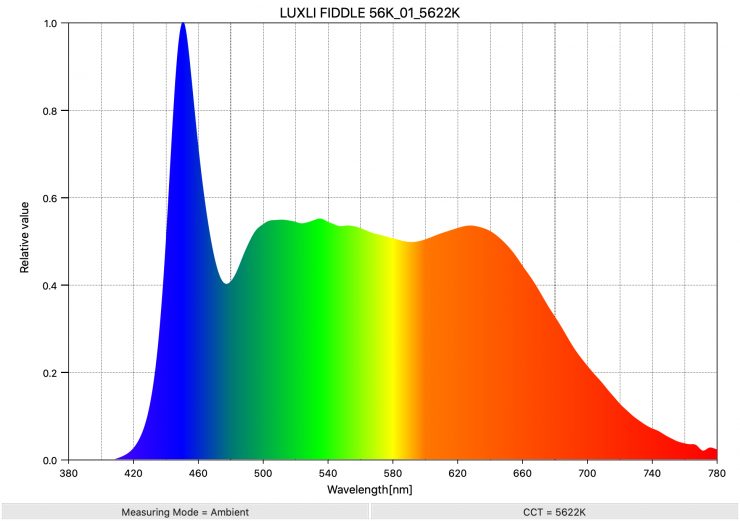
Above you can see the spectral distribution of the Fiddle when it is set at 5600K. The spectral distribution is very full and even.
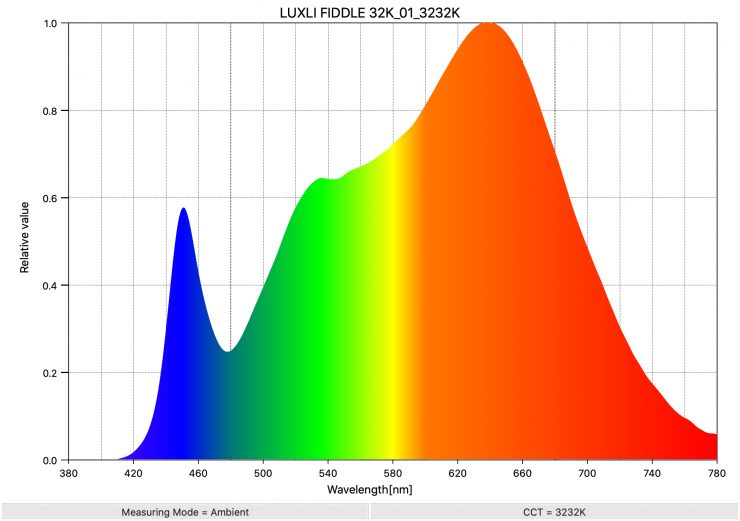
Above you can see the spectral distribution of the Fiddle when it is set at 3200K. The spectral distribution is nice and full and there is only a light push towards green.
Real-World Performance & Quality of Light
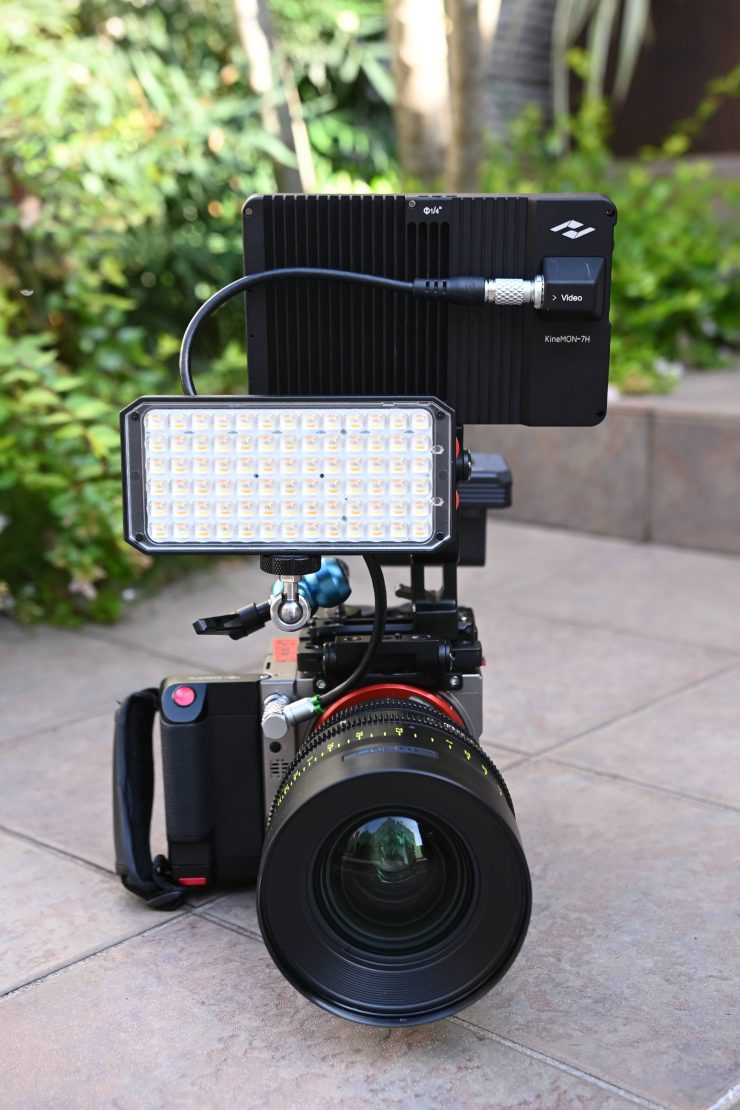
As I always say, photometric scores only tell you part of the story. So do the scores from the Fiddle translate into real-world performance? The quality of the light that is coming from the Fiddle is really nice, however, it really does need some diffusion to be softened up. The photometric data can only give me scientific data and it is much more important for me to see how the light looks and performs with skin tones.

No diffusion 
Diffusion 
Light off
Above you can see what the light looks like at 100% power without diffusion, with diffusion, and with the light turned off. The light is about 3′ away from me. The lights output is ok, but it isn’t going to do a lot unless you are indoors.
The light can be made to look quite soft, but again, anytime you diffuse a small source you are going to lose a lot of output.
If you don’t diffuse it you will get hatched shadows if the object you are illuminating to too close to something else. In most instances, you probably won’t be doing this with a light, but it is important that you are aware of it.
The Fiddle gives you a good combination of output, usability, and useful features. This all comes with the added benefit of the light being extremely color accurate. Look. it isn’t overly bright, but it is brighter than most of the other similar-sized RGB lights that are available.
Having digital filters, and special effects are nice, but most users will just want to create really nice white light, and that is something the Fiddle does really well.
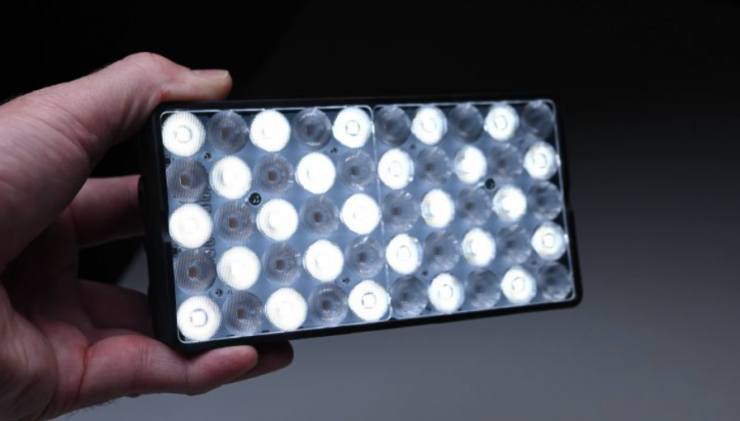
If you are after an on-camera light that has a lot of output you are better off looking at something like the Lupo Smartpanel. The Lupo has about 8 times the output of the Luxli, but you need to remember it is a bi-color light, and it doesn’t have an internal battery.
Firmware Updatable
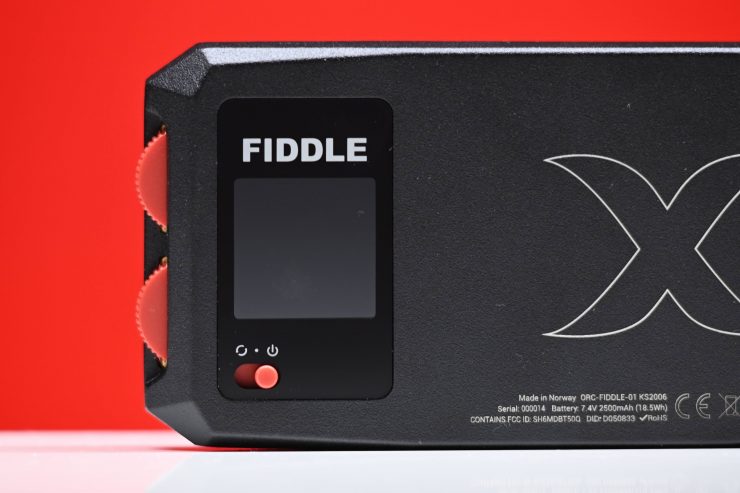
Like a lot of today’s lights, the Fiddle is fully firmware upgradeable.
Who is the Fiddle aimed at?
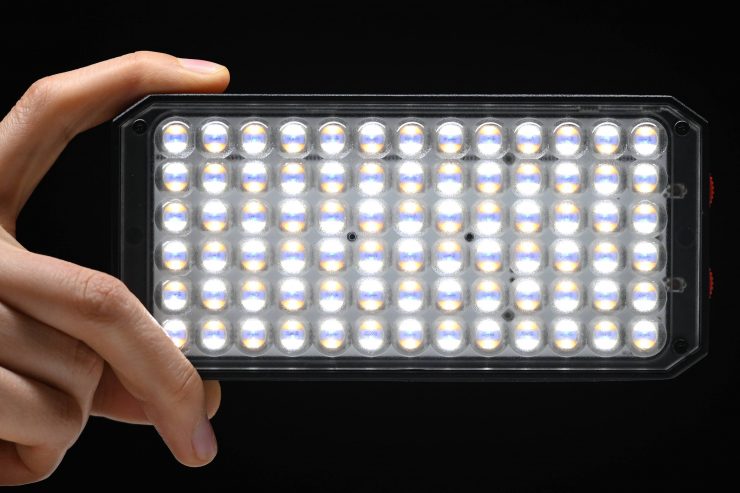
The Fiddle could be used for a lot of different applications, but it is probably a fair assumption to say that it is being aimed as an on-camera light, or small accent light for owner-operators or even YouTubers.
The light is competitively priced given its feature set and performance, although it will cost you a little more than some other similar alternatives on the market.
Other Alternatives
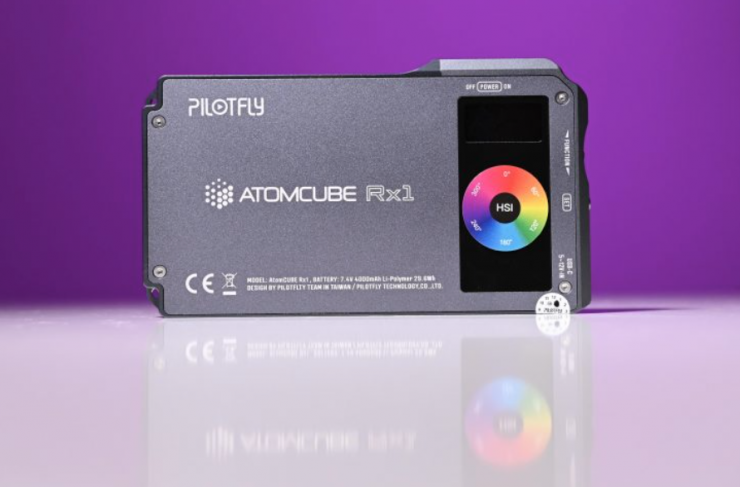
The main competition for the Fiddle comes in the form of the following lights:
- PFY Matrix Pocket-Sized Portable Bi-Color RGB Light
- Pilotfly AtomCUBE Rx1 RGBCW Pocket LED
- YY-C150 RGB LED video light
- BOLING Pocket LED RGB Video Light
- Aputure MC RGBWW LED Light
- Falcon Eyes PockeLite F7 RGBW On-Camera Light
All of these lights have their strengths and weaknesses. It is important to note that a lot of these competing lights are actually the same light that has just been rebranded under a different name.
Price & Availability
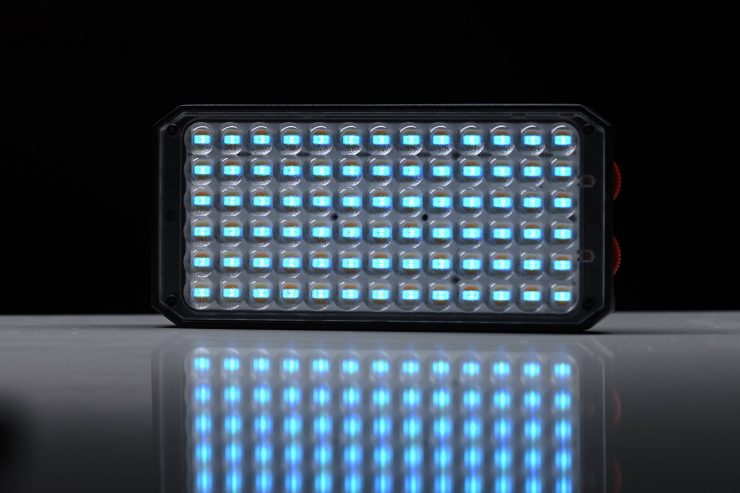
The Luxli Fiddle is well priced at $199 USD. This cost makes it a little higher than all of the competition. However, I personally think that the Fiddle is a better option than any of these other options given its output, battery life, and color rendering performance.
Below you can see how the price compares to the competition:
| Price | |
| Luxli Fiddle | $199 USD |
| PFY Matrix Pocket-Sized Portable Bi-Color RGB Light | $149 USD |
| Pilotfly AtomCUBE Rx1 RGBCW Pocket LED | $169 USD |
| YY-C150 RGB LED video light | $69 USD |
| BOLING Pocket LED RGB Video Light | $119 USD |
| Aputure MC RGBWW LED Light | $90 USD |
| FalconEyes PocketLite F7 RGB LED | $99 USD |
Specifications
| LED TYPE | 5-Die RGBAW |
| BEAM ANGLE | 72° |
| KELVIN COLOR TEMPERATURE RANGE | 2800 to 10,000K |
| COLOR ACCURACY STANDARD | TLCI: 97 CRI: 95 |
| COOLING SYSTEM | Passive |
| DIMMING | 0% to 100% (continuous) |
| HOUSING MATERIAL | Aluminum |
| LEDS | 78 |
| OUTPUT | @ 3 ft. 375 lx |
| RECTANGULAR PANEL SIZE | (W × H) 5.1 × 2.4 in. (13 × 6.1 cm) |
| FIXTURE DIMENSIONS | (W × H × D) 6.1 × 2.9 × 0.8 in. (15.4 × 7.3 × 2.1 cm) |
| WEIGHT | (without battery) 8 oz. (226.9 g) |
| CONNECTORS | DC Connector USB Type-C |
| MOUNTING | Fixture Mount 1/4-20 female socket (×2) |
| POWER | USB PD Input 9 V, 12 V, 15 V |
| POWER DRAW | 18 W |
| WARRANTY | One-Year Limited |
In the Box
• Luxli Fiddle Pocket RGBAW LED Light
• USB Type-C wall charger
• USB Type-C cable
• QuickStart guide
• Photometric Calibration Datasheet
Accessories
Luxli offers a lot of optional accessories for the light. These include:
- Vello Multi-Function Ball head
- Elvid Heavy-Duty Ballhead
- Axler Mini Arm (3.5 in.)
- Axler Recodo Articulating Arm (7 in. & 111 in. versions)
- Impact Atom Clamp With 1/4 to 3/8 Screw Adapter
- Magnetic Diffuser Hood
- Xcellon 54W Dual USB Type-C PD Car Charger
Kits
There are also a few kits available:
- Luxli FIDDLE TABLETOP KIT $218.95 USD
- Luxli FIDDLE OUTDOOR KIT $233.94 USD
- Luxli FIDDLE MAGNET KIT $221.98 USD
- Luxli FIDDLE + DIFFUSER KIT $228.95 USD
Conclusion
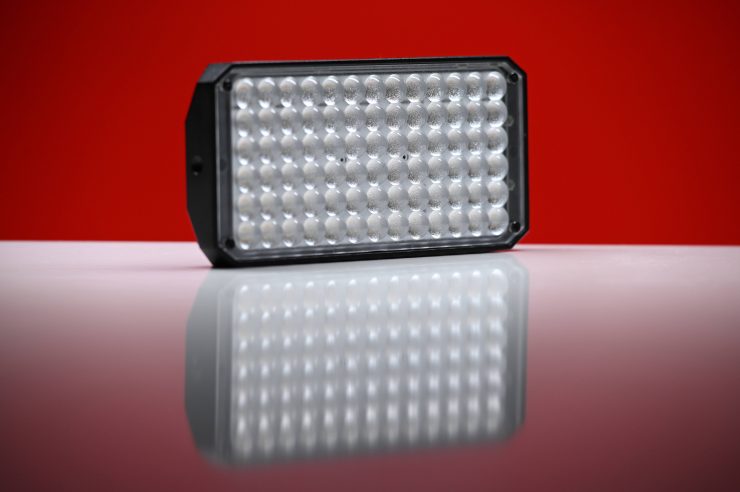
The Luxli Fiddle is a very, very good light. It offers extremely good color rendering performance, a nice amount of output, good build-quality, and fantastic app control.
The output is almost identical no matter what Kelvin color temperature you run the light at and it is very Kelvin color-accurate across its whole range. This light is super consistent.
The interface and operating system are straightforward and intuitive to use. The Luxli Composer App is one of the best lighting control apps that is available.
The Fiddle is an impressive light, and Luxli has done a fantastic job with this fixture. It delivers on all fronts and if you are after a small-sized on-camera RGB light then you should take a long hard look at the Fiddle.
Like what we do and want to support Newsshooter? Consider becoming a Patreon supporter and help us to continue being the best source of news and reviews for professional tools for the independent filmmaker.

